Osaka is known for lively nightlife and endless street food, but there’s more hiding beneath this city’s neon-lit facade. We’re going to walk you through the best things to do in Osaka — from can’t-miss attractions to some lesser-known secrets that you won’t find in guidebooks!
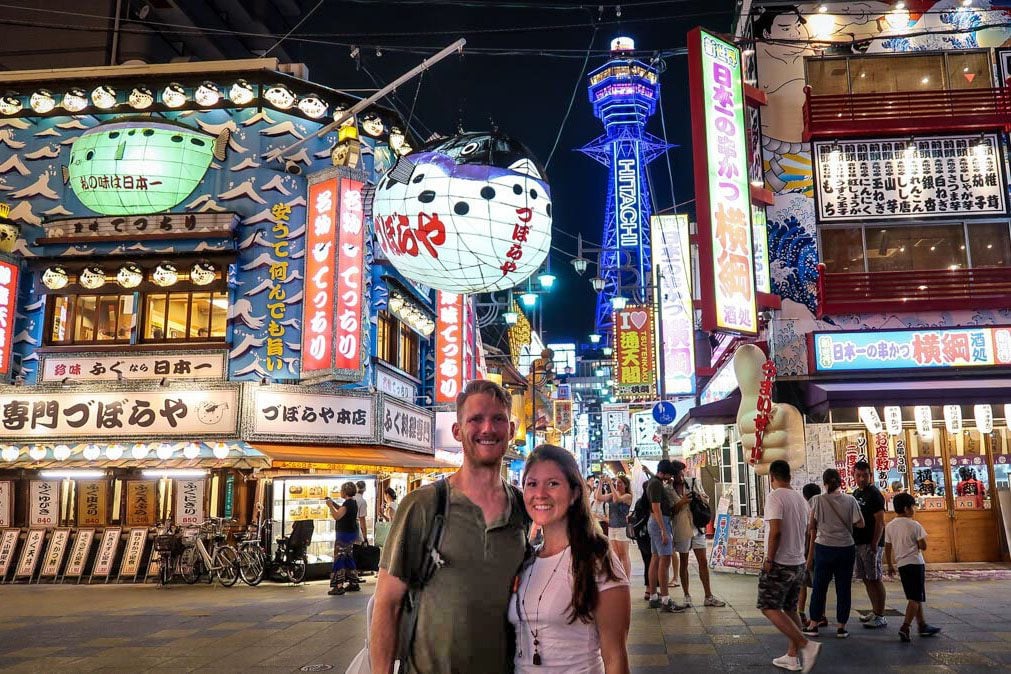
Known for vibrant nightlife, approachable locals, and a fantastic food scene, Osaka is a popular spot on most Japan itineraries.
Truth time: When we plan trips, big cities aren’t usually the spots we most look forward to visiting. And honestly, we didn’t really expect to like Osaka (aka Japan’s third largest city!) all that much.
Osaka lacks the old world charm you’ll find in Kyoto, and it’s not as flashy as Tokyo. But what it lacks in glamour and beauty it makes up for in character. Osaka is friendly and laid-back, and we ended up liking it much more than we expected.
Our favorite things to do in Osaka
If we had to choose our very favorite things to do in Osaka, this list would be it!
Now your trip to Osaka is off to a great start!
But don’t stop here…
We created a video of our experience that walks you through our favorite things to do in Osaka. So grab your popcorn and watch the city come alive!
Want more ideas? Well, you are in for a treat, my friend!
In this article, we’re sharing all the best things to do in Osaka; from the famous must-see Osaka attractions, to tours that are absolutely worth the price tag, to some hidden spots you won’t find in the guidebooks.
Let’s jump right in…
1. Explore Dotonbori at night
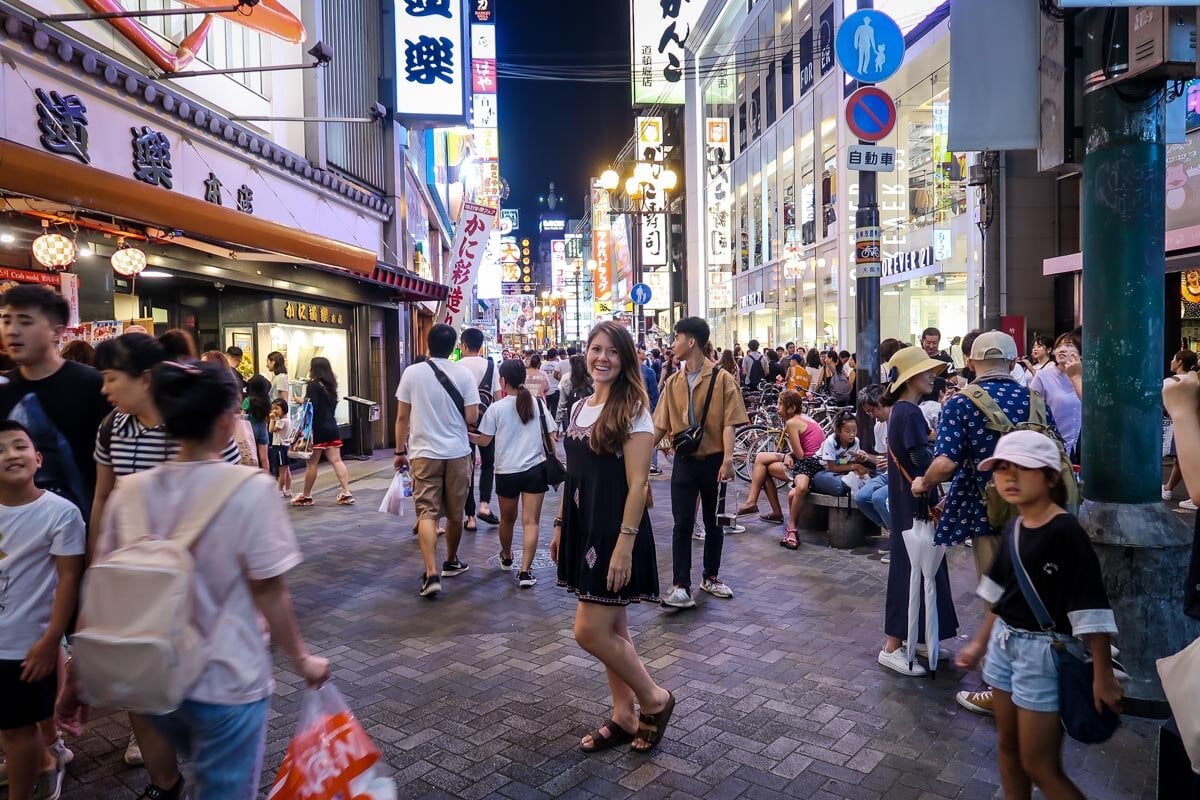
Known for its ever-glowing neon lights, thick crowds, and endless food options, Dotonbori is a must-visit when in Osaka.
To get the full experience, be sure to get there after the sun goes down and the lights shine brightest. There is a palpable buzz to this place, and your senses will be on overdrive. We enjoyed walking up the main drag, grabbing street food along the way and finding a seat to eat and people-watch.
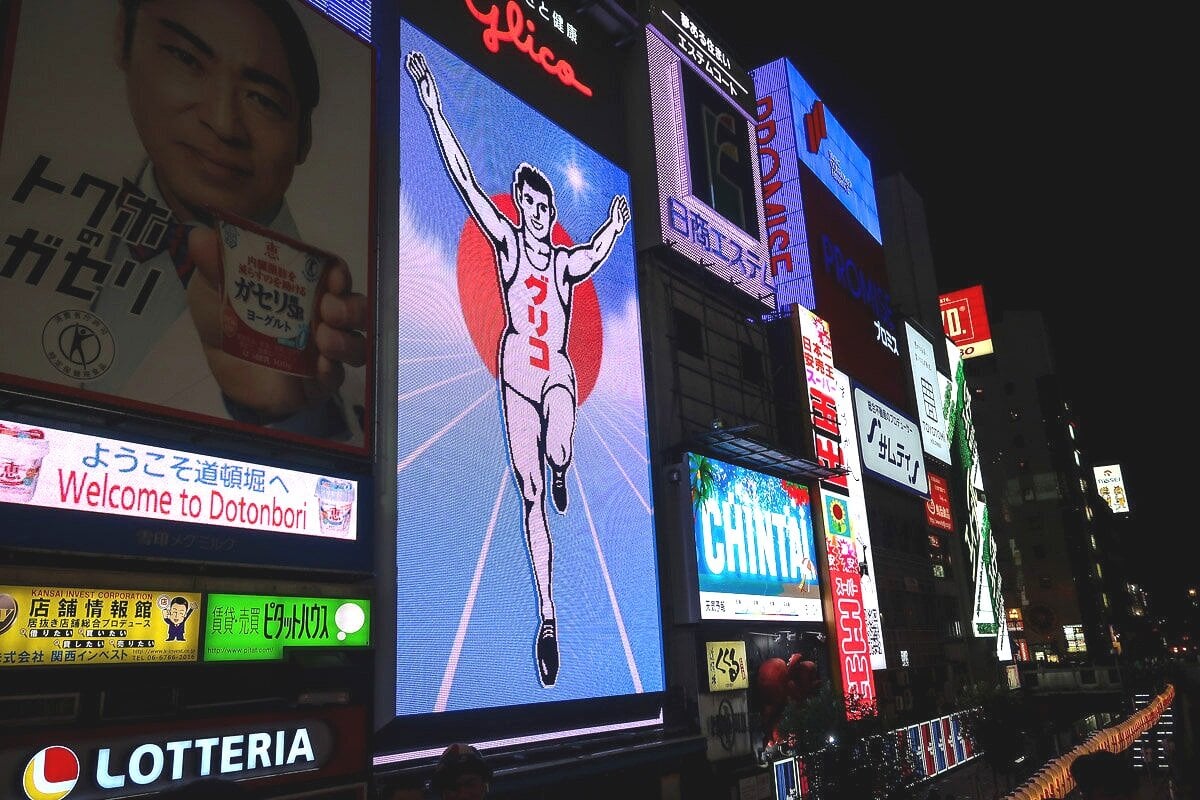
While in Dotonbori, do the Japanese thing and take a photo with “Glico Man”, the runner depicted on a neon billboard crossing a finish line. This iconic image was installed in 1935 by a candy company (Glico), and it is now the symbol of Osaka amongst Japanese people.
Also, stop into Don Quijote, which is a famous Japanese discount store chain that sells literally everything you could ever need. Just walking inside one of these stores is an experience in itself, and the Dotonbori location even has a ferris wheel inside!
Insider tip:
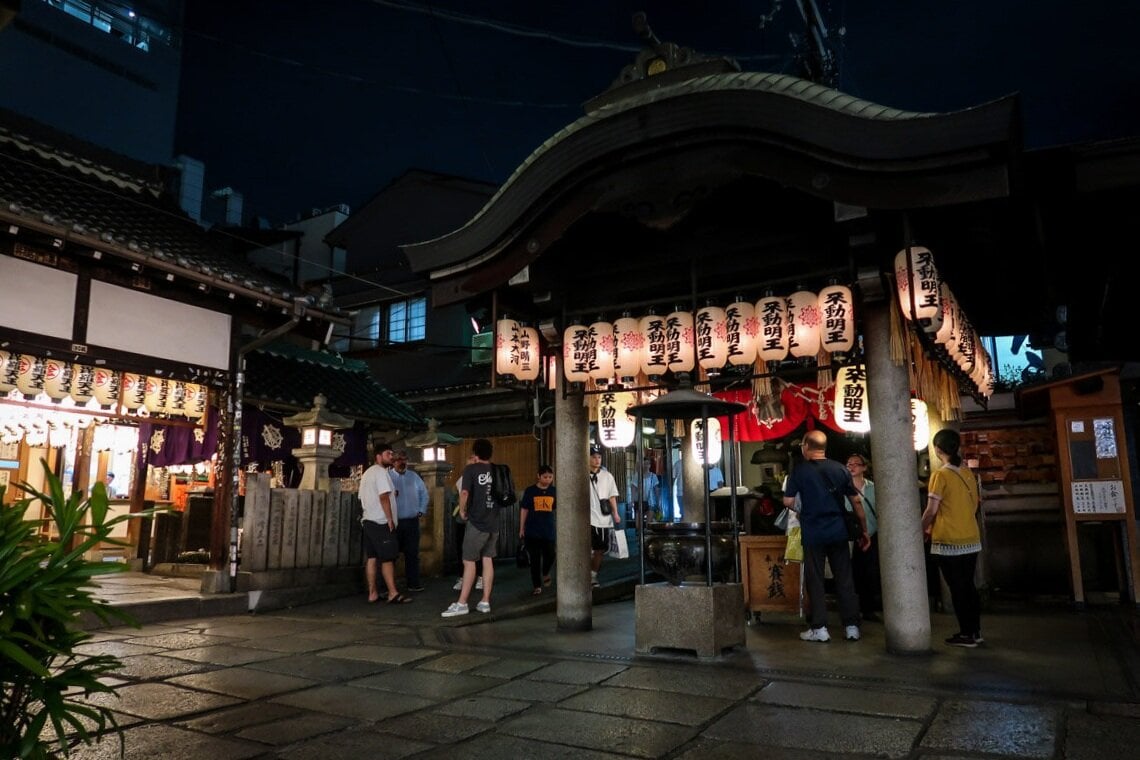
While you’re in the area, wander off the main path and through narrow streets towards Hozen-ji Yokocho, an alleyway that still retains traditional charm and is much quieter than Dotonbori’s main drag.
Be sure to pause at the lantern-lit Hozen-ji temple, for which this alley gets its name.
2. Take a cooking class
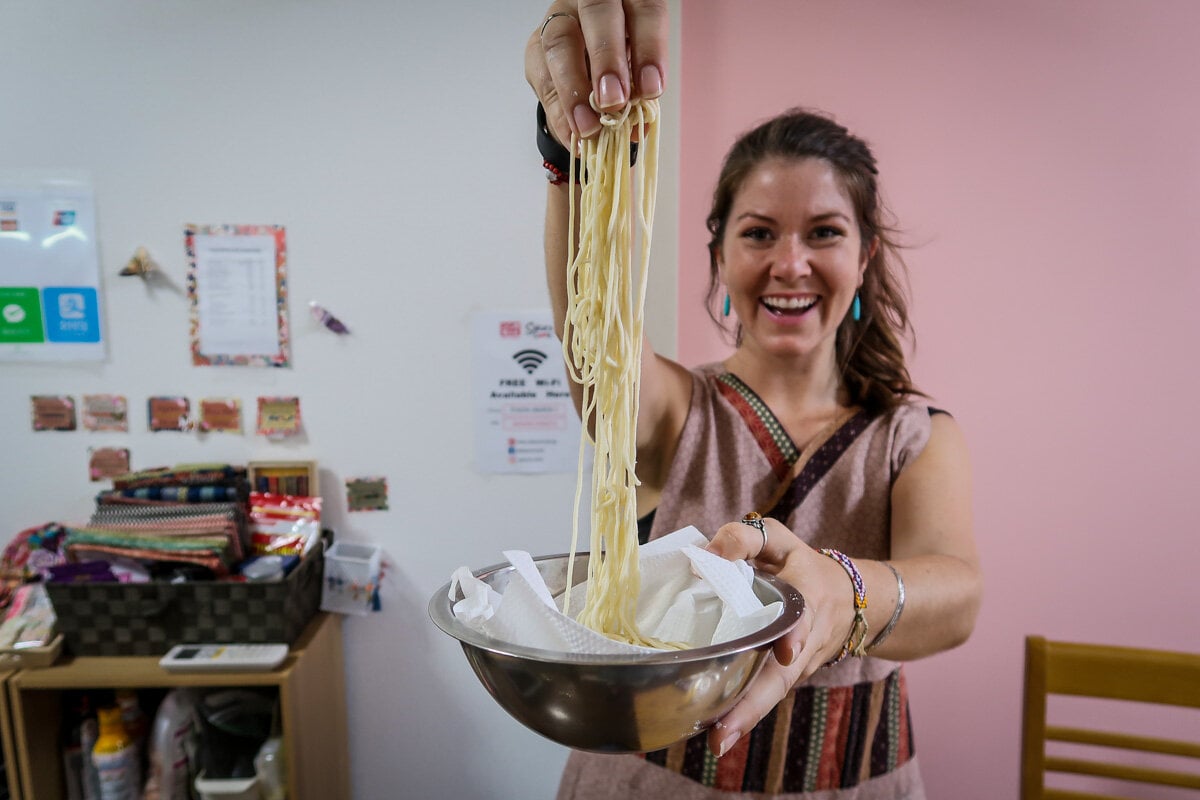
If you’ve been following our blog for a while, you might know that we love taking cooking classes on our travels, and have taken classes in 12 countries around the world (and counting!).
We think a good cooking class can give you a unique opportunity to spend time with a local, ask questions, and learn. Also, food is such an integral part of a country’s culture that taking a cooking class will give you a perspective you might otherwise miss.
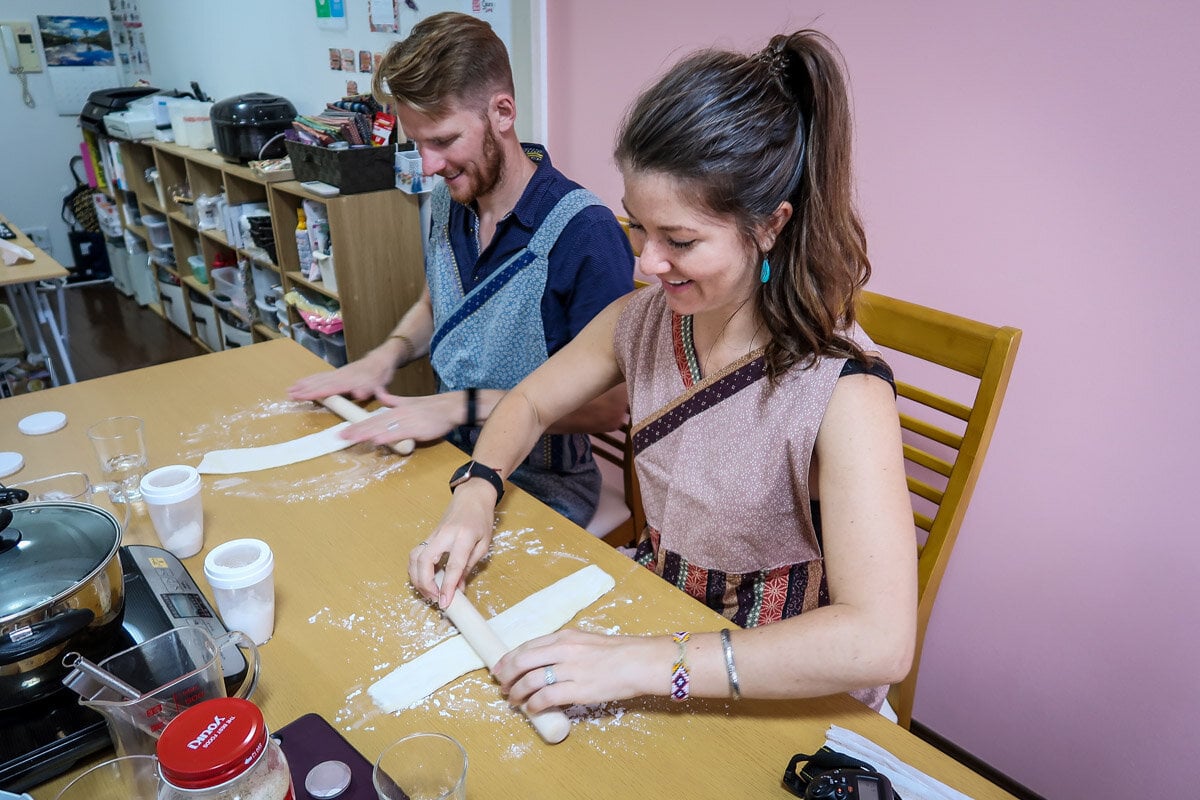
Many of the cooking classes we’ve taken are half-day affairs, with visits to local markets and preparing multiple dishes from scratch. However, this ramen-making class took just 2 hours, which was fine with us considering we had a pretty packed schedule in Osaka.
Our hosts were very sweet and explained the different types of ramen (there are a lot!). We prepared three different types of ramen and made everything — from the noodles to the broth — from scratch.
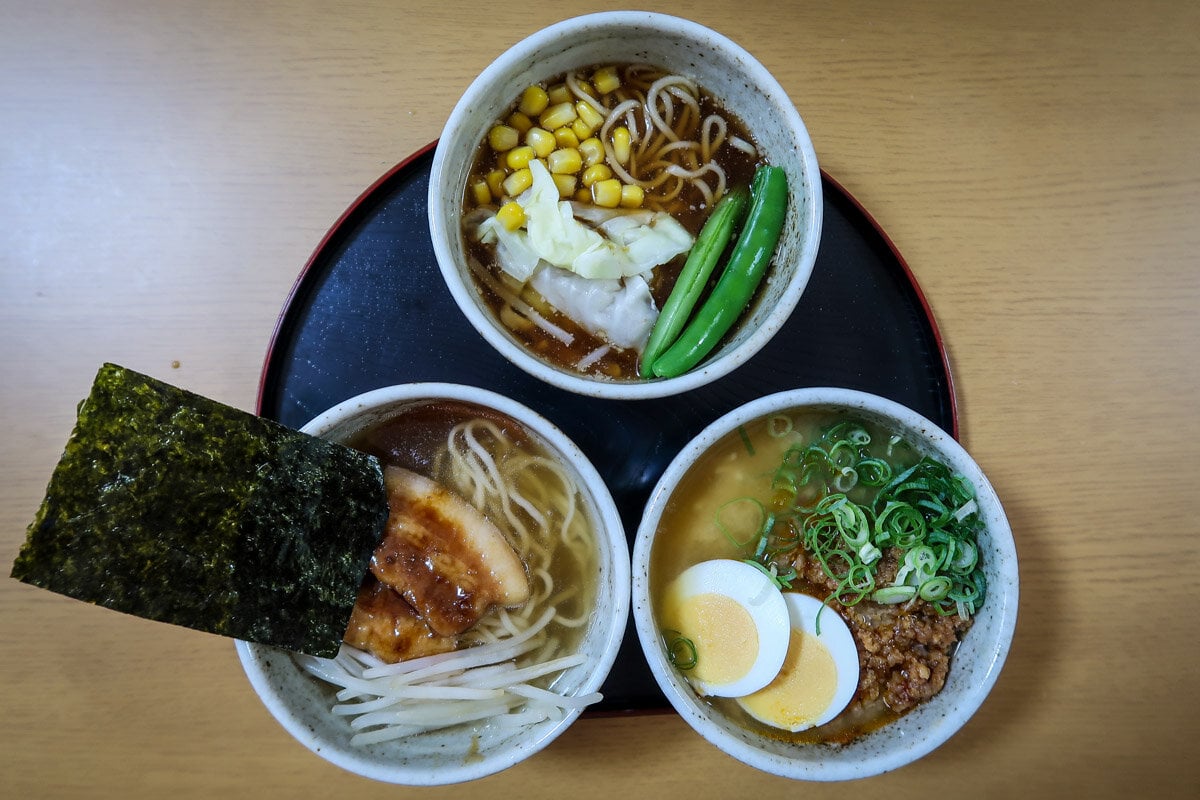
Note for vegetarian travelers: This cooking class can be adapted for vegetarians and vegans.
One thing I will mention is that while it was really fun to make our own ramen from scratch, it is not a dish that average Japanese people will make for themselves. They’ll typically go to a ramen shop instead of cooking this dish from scratch at home.
Note: We were hosted by Sakura Cook in our ramen-making class, but all opinions are our own.
3. Visit the Shiteno-ji Temple
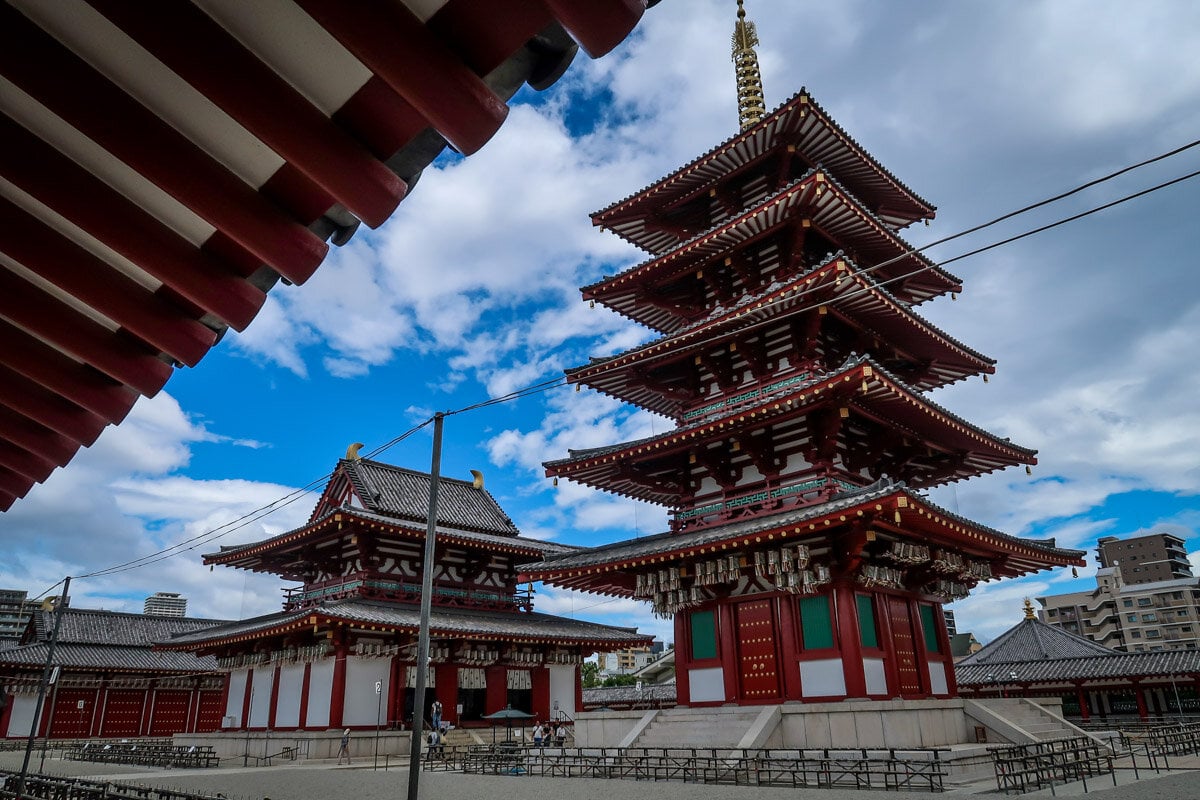
One of the oldest temples in Japan and the most important Buddhist structure in Osaka, the Shitenoji Temple is a good place to get a glimpse into the country’s religion.
This temple was originally built in the 6th century by Prince Shotoku as a way to help promote the introduction of Buddhism to Japan. Over the centuries, Shitenoji has endured several fires and has been reconstructed to reflect the original design.
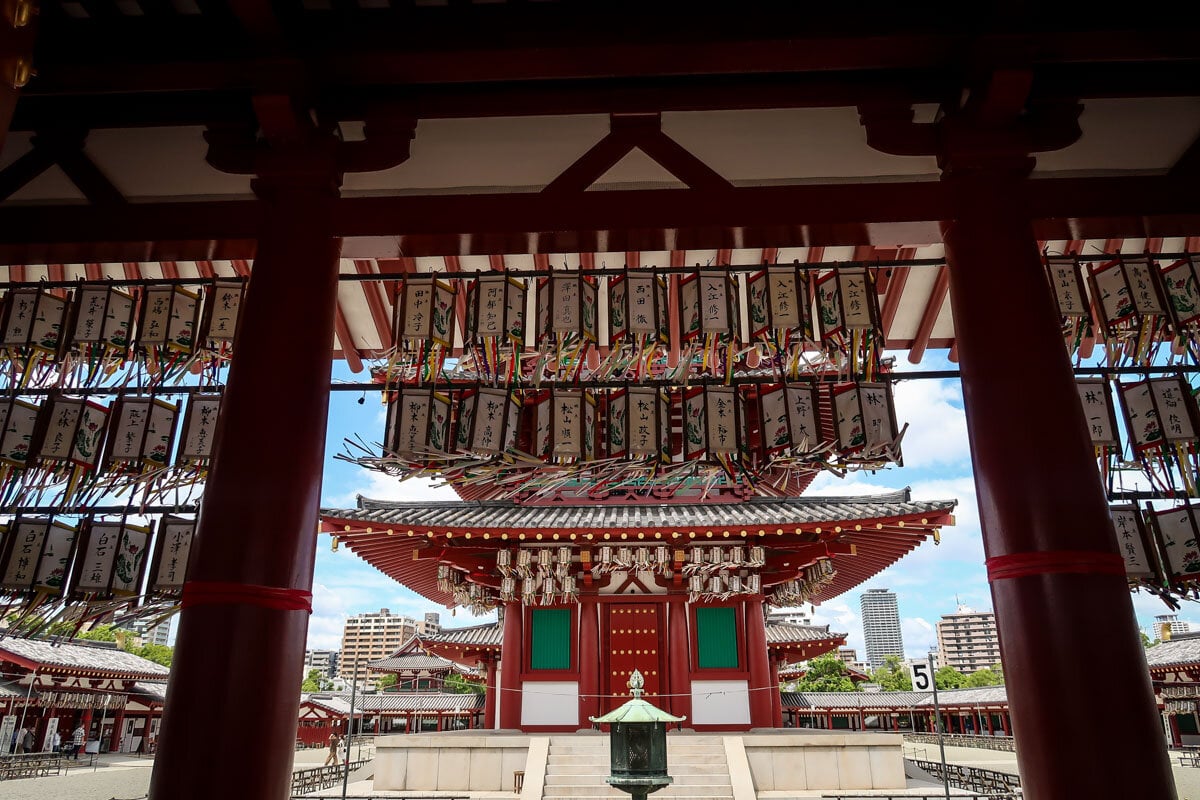
Helpful info
- Cost: It’s free to enter the main temple grounds, but there are small fees for two of the onsite attractions:
- Gokuraku-jodo Garden: 300 yen
- Treasure House: 500 yen; you can see historic paintings and writings displayed
How to get here: Shitennoji is a short walk from Shitennoji-mae-Yuhigaoka Station on the Tanimachi Subway Line. Alternatively, it can be reached in a ten-minute walk north of JR Tennoji Station on the JR Loop Line.
4. Go izakaya hopping
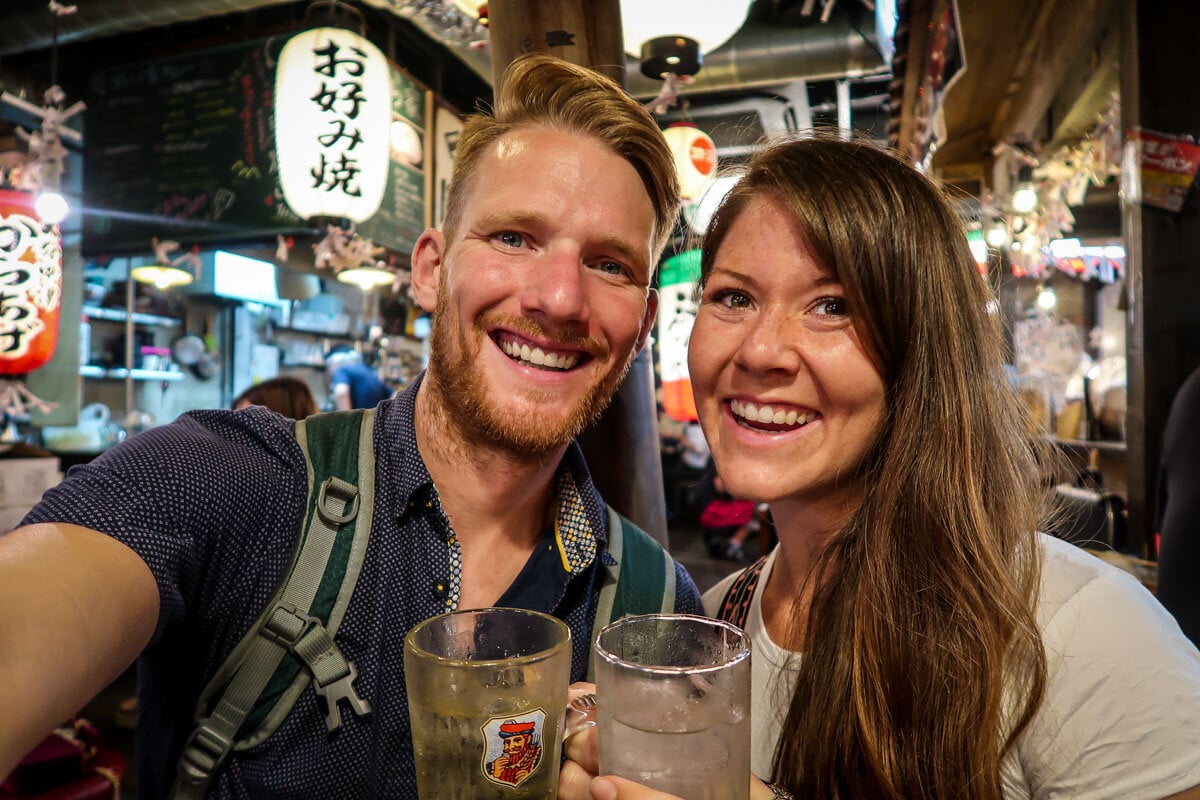
Let’s start by defining what the heck an izakaya actually is.
Izakaya: small bar that serves drinks and small dishes in a casual atmosphere.
Sometimes izakayas have just a handful of seats, and other times they have a second floor with more seating. But one of their defining features is that they are cozy, they serve drinks and small dishes, and they are are good places to soak up local ambiance.
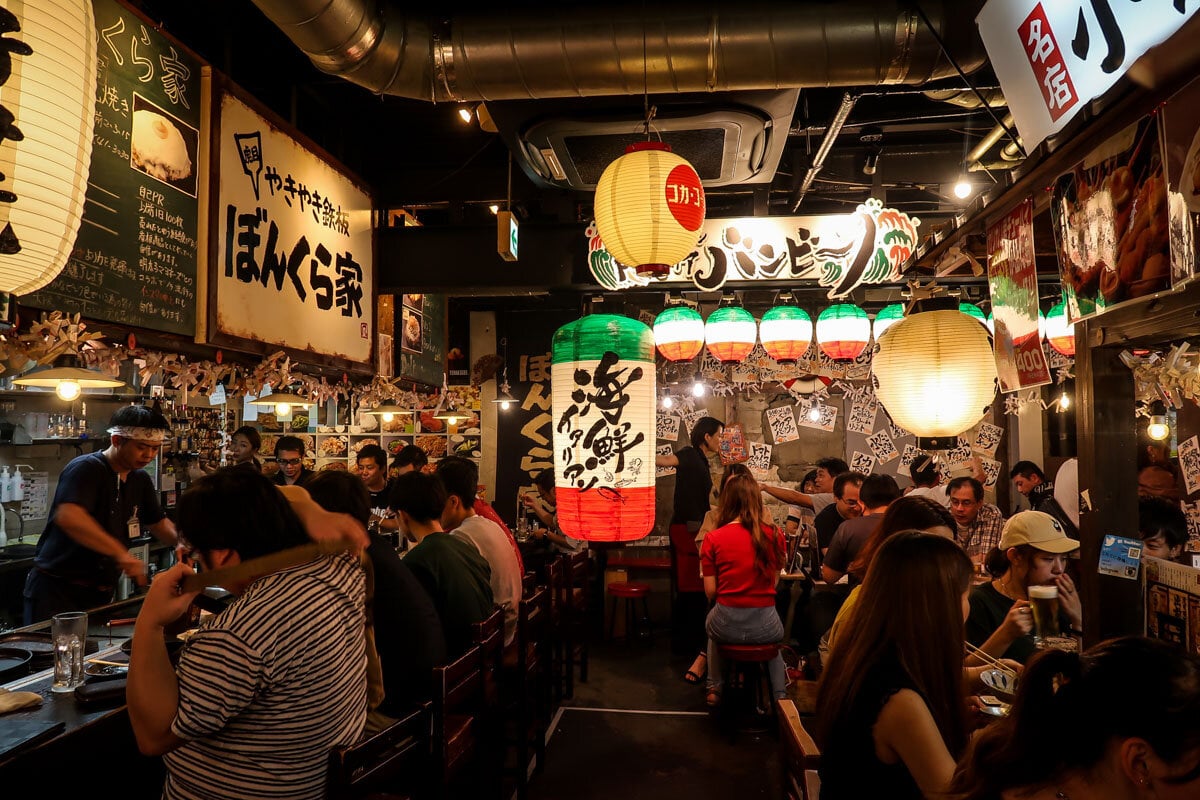
Izakayas are uniquely Japanese, and a fun thing to do in Osaka during your visit. You’ll be surrounded by locals and have the opportunity to absorb this special atmosphere.
Want some tips on what to order in an izakaya? The menus are often written in Japanese, which can make things a bit tricky. But don’t worry, we’ve got you covered with a guide to ordering at an izakaya!
Magical Trip Bar Hopping Tour
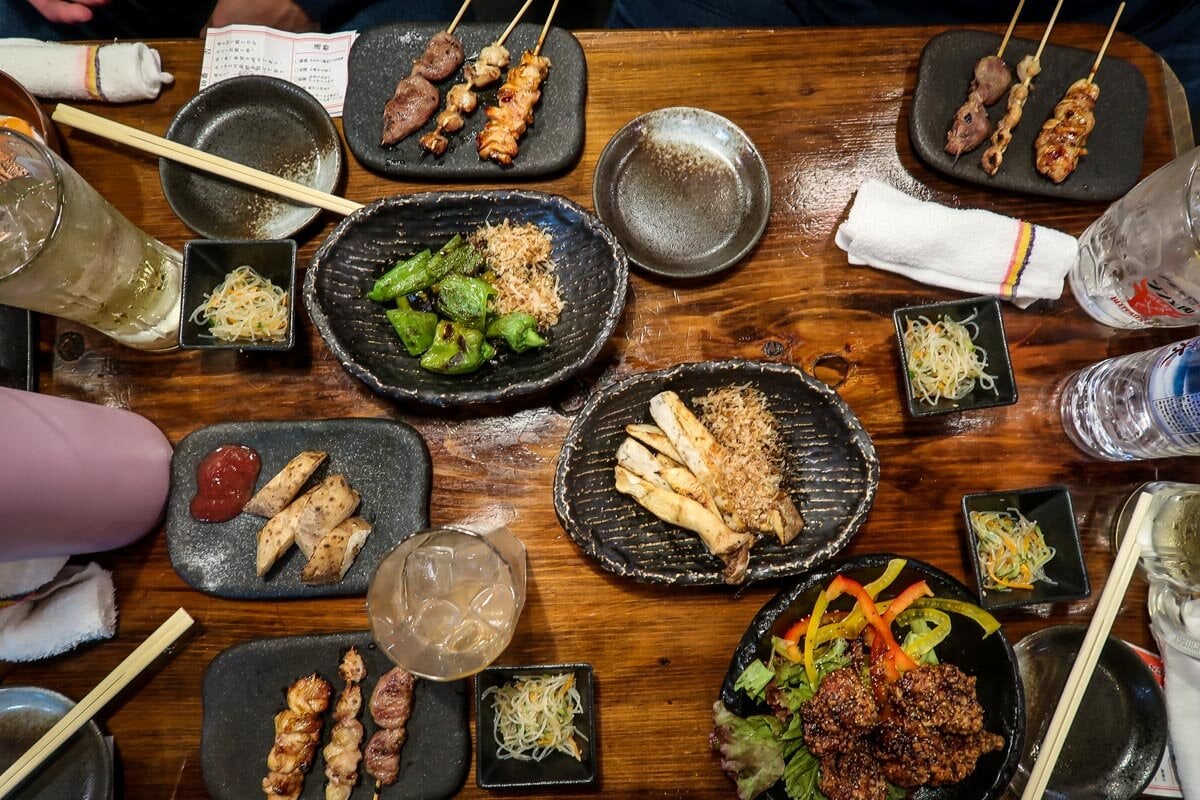
If you’re traveling solo or want a local with you on your first izakaya experience, consider booking a bar hopping tour with Magical Trip.
Is it worthwhile?
Short answer: Maybe…
Long answer: We did a bar hopping tour with Magical Trips, and we’re gonna be honest: In our opinion, the tour was just okay. Our guides were nice, but didn’t give us all that much information that we didn’t already know, so we felt like we could have had a very similar experience on our own without paying the price of the tour.
That said, we’ve traveled in Japan before and feel confident stepping into izakayas on our own. And I will admit, it can be a bit intimidating entering your first izakaya because most of the time the menus are in Japanese.
So if it’s your first time in Japan or you’re traveling solo and want some company, having a local with you (and potentially some other travelers) can make the experience a bit more comfortable and fun.
Insider Tip: If you’ve seen the Netflix Street Food series, you might recognize Toyo, the lively izakaya featured in the Osaka episode. Known for tuna cheek, crab, and fatty tuna rolls, it’s best to arrive early—popular dishes sell out fast! Beyond the food, we really enjoyed chatting with the energetic chef-owner. Located in Miyakojima, it’s an easy stop on the JR Tozai line (especially if you have the JRail pass!).
5. Visit the Osaka Castle
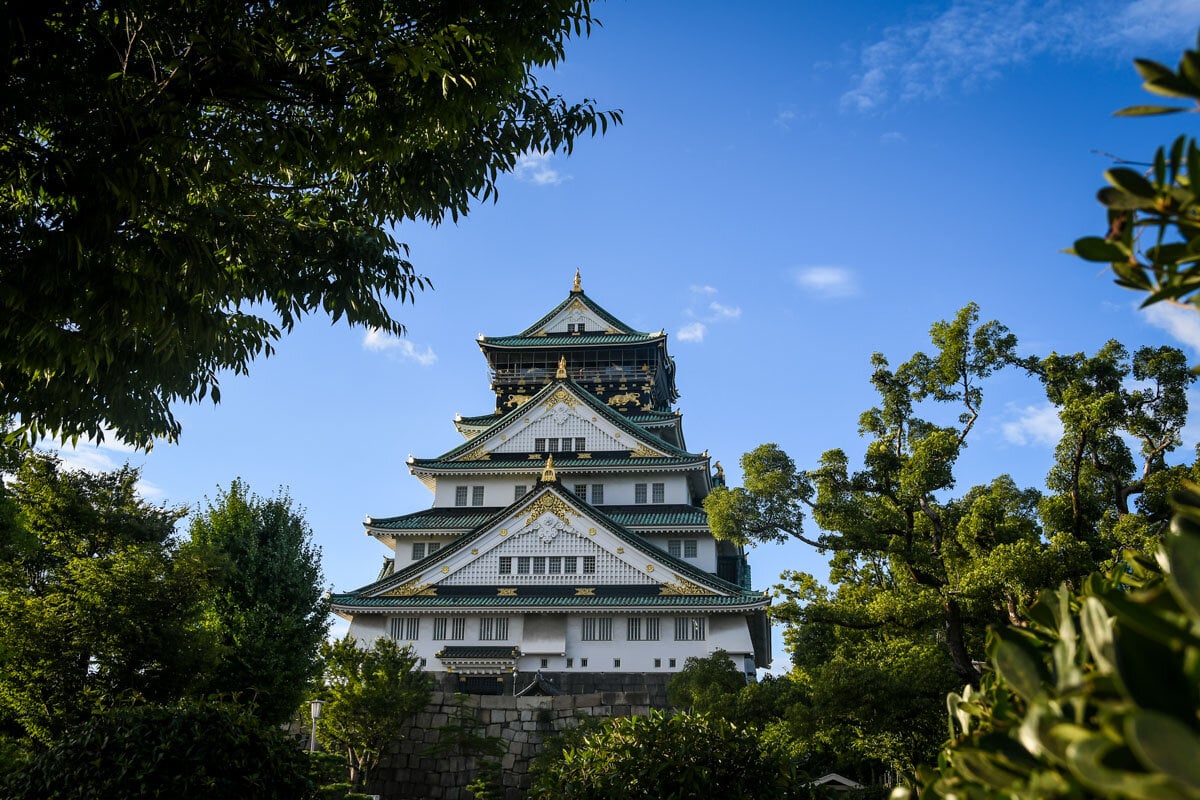
Situated in the midst of this bustling city, the Osaka Castle is one of Japan’s iconic landmarks and a must on most travelers’ itineraries. Cross over not one — but two! — moats to reach the castle grounds, which you can explore free of charge.
If you want to enter the castle, you’ll need to pay an entrance fee. The interior has been turned into a museum and, in our opinions, was a bit underwhelming.
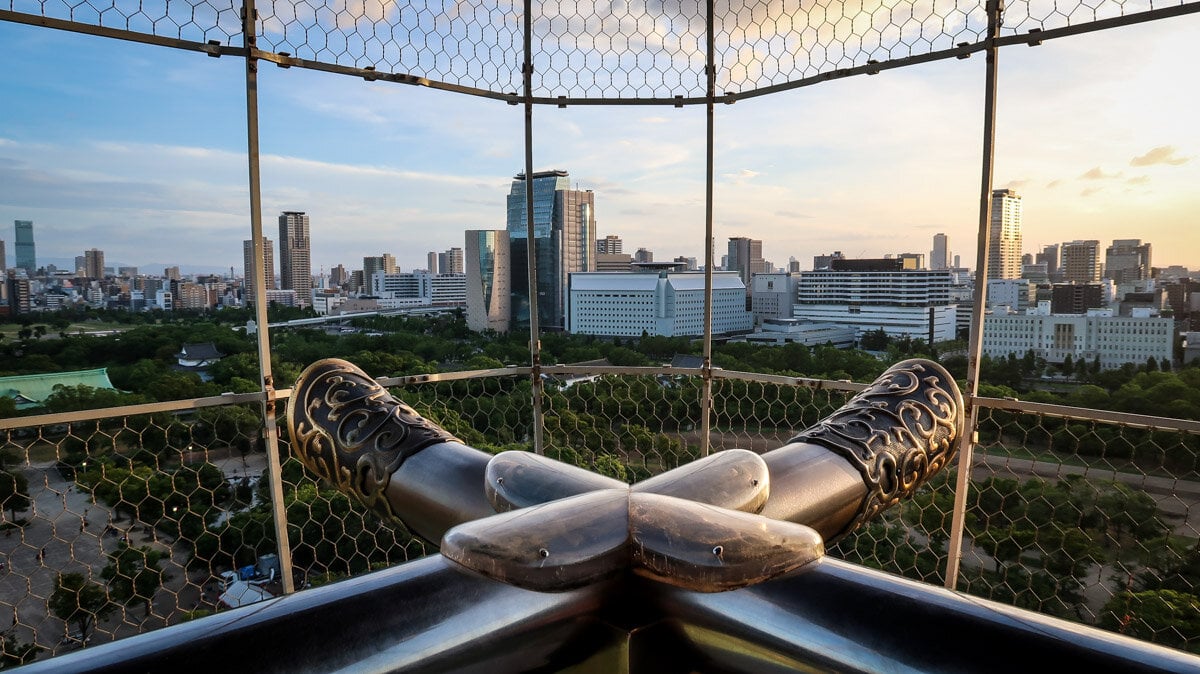
The best part of the admission (for us) was the observation deck on the 8th floor. It offers nice 360-degree views over the city.
Helpful info:
- ¥600 to enter museum & observation deck
- Free to enter the castle grounds
- Hours: 9am – 5pm
- last entry at 4:30pm
- extended hours on holidays
- Google Maps Location
How to get there: The closest station is Tanimachi Yonchome Station along the Tanimachi and Chuo subway lines. And the closest JR station is Osakajokoen Station on the JR Loop Line.
Nishinomaru Garden
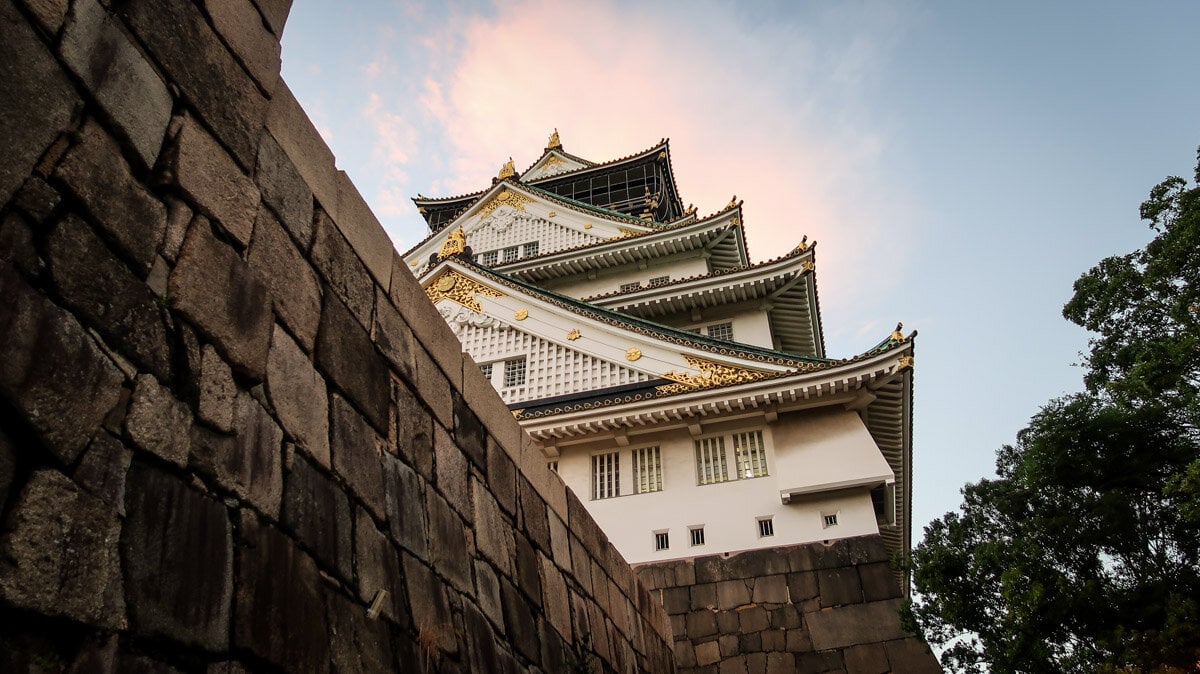
- Entrance fee: 200 yen (or 350 yen during the extended hours of the cherry blossom season)
Surrounding the castle lies the Nishinomaru Gardens, which are one of the most popular spots in the city for cherry blossom viewing in the springtime. It also offers nice views of the castle and lots of green space that is nice any time of year.
Insider Tip:
One of the best views of the castle itself is from the rooftop of the nearby Miraiza building, which has bathrooms and shops. Blue Birds Rooftop Terrace is a good place to grab a drink & enjoy the view. (Skip the food, according to the reviews).
Entry is ¥1,000 with a drink included, or free with an Osaka Castle ticket or shop receipt—just buy a drink (¥500). Plan your visit between 11 a.m. and 4 p.m., as they close from 4–6 p.m. for dinner setup.
6. Wander the Kuromon Ichiba Market
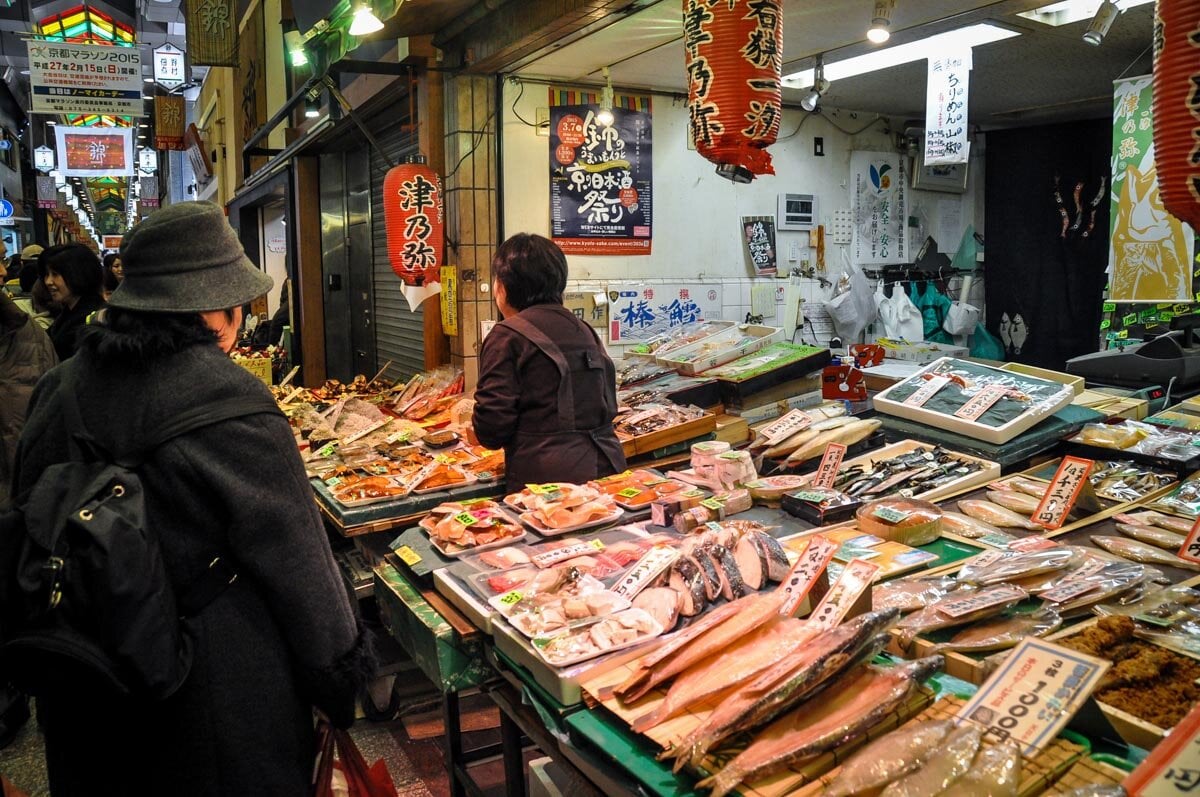
This covered market is where chefs and home cooks come for the freshest local ingredients, earning it the nickname “Osaka’s kitchen”.
Not only will you find stalls selling fresh seafood and produce, but you’ll find shops serving up fresh food made on the spot, like noodles, curries and takoyaki.
Wander past the stalls, sample some dishes, and observe locals on their morning grocery runs.
How to get here: This famous market is a short walk from both Nippombashi and Kintetsu Nippombashi stations.
→ Looking for a way to fit all this in? Our 2 day Osaka itinerary has all of the logistics and details planned for you!
7. Explore Minoo Park
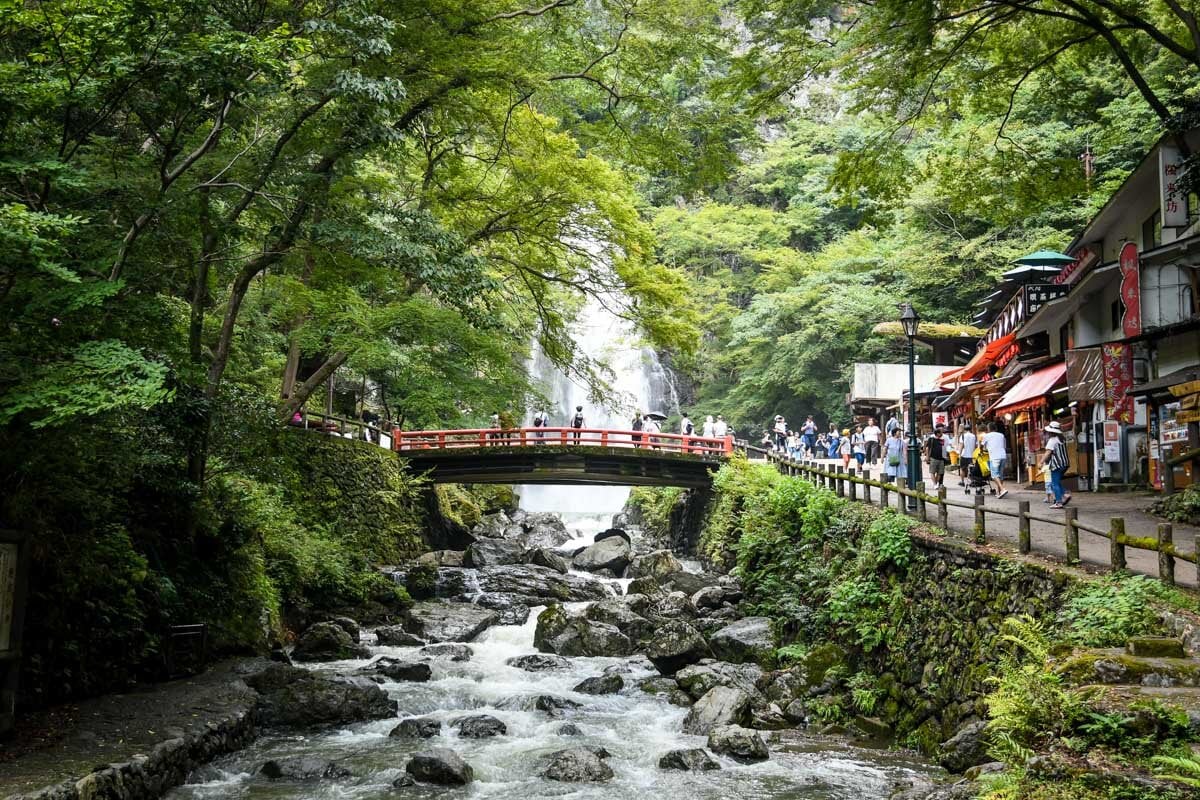
After a few days in the city, we were craving some nature—and found it just 45 minutes north of Osaka at Minoo Park.
This peaceful escape features a mostly flat, paved path through forested hills to a scenic waterfall. It’s a favorite local day trip for couples and families, with snack stalls and restrooms along the way.
Check out our full Minoo Park guide for how to get there, what to do, and a unique foodie experience you won’t want to miss.
8. Check out the teamLab Botanical Gardens
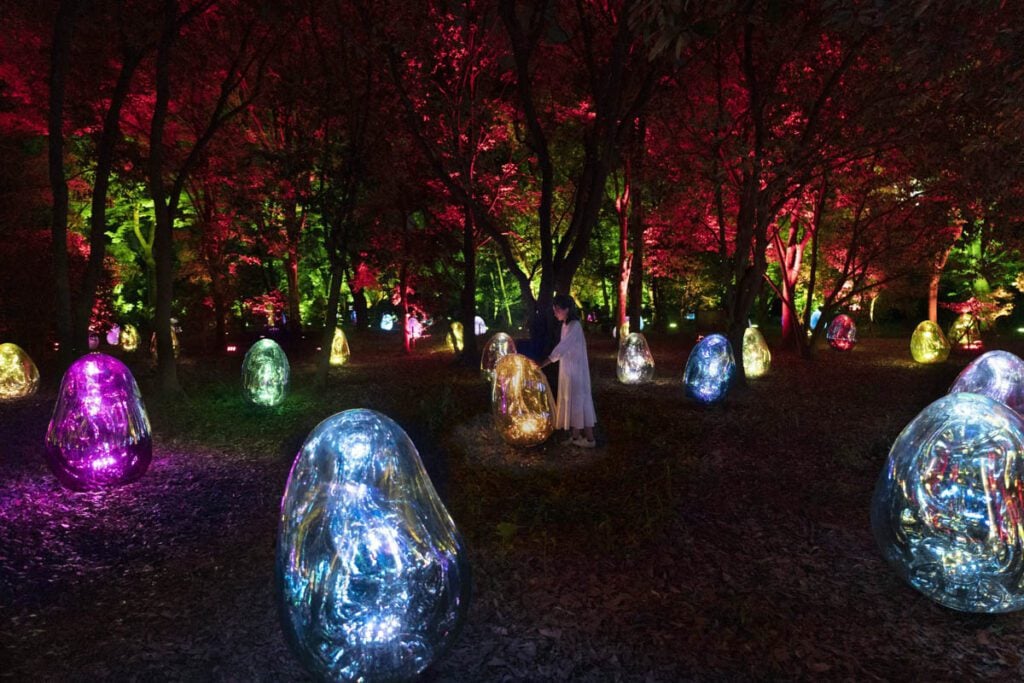
You’ve heard of teamLab Borderless, the ultra-popular digital art museum in Tokyo. But what if we told you you could get a taste of the teamLab magic in Osaka?
As of July 2022, teamLab has opened a new exhibit at the Nagai Botanical Garden in Osaka. The project, called Digitized Nature, explores the concept of turning nature into art using non-material digital technology that won’t harm the plants.
A botanical garden during the day and art space by night, this is easily one of the coolest things to do in Osaka since it opened! Check their official website for more details and snag your skip the line entry ticket online ahead of time.
9. Go on a food tour
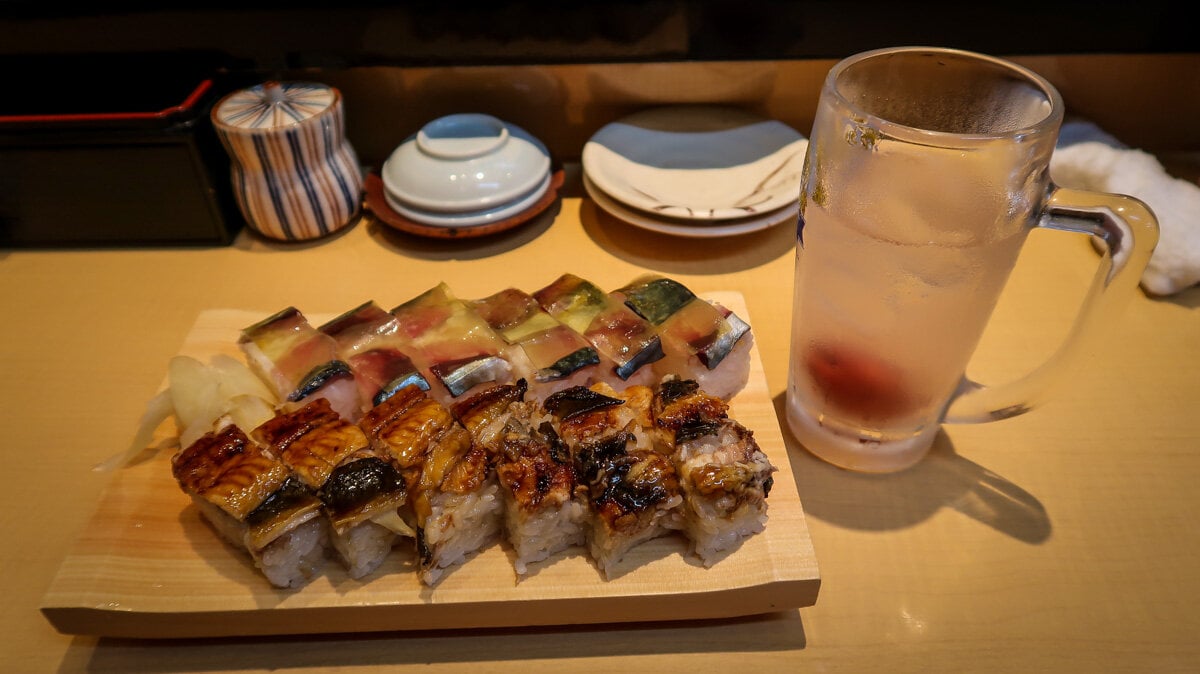
Osaka is known for food, and it would be a shame not to stuff your belly with as much as possible in this foodie paradise.
You can try wandering around the streets and let your nose guide the way, but if you want to sample the best local dishes and learn all about local foodie culture, you’ll be impressed with Arigato’s Osaka food tours. We sure were!
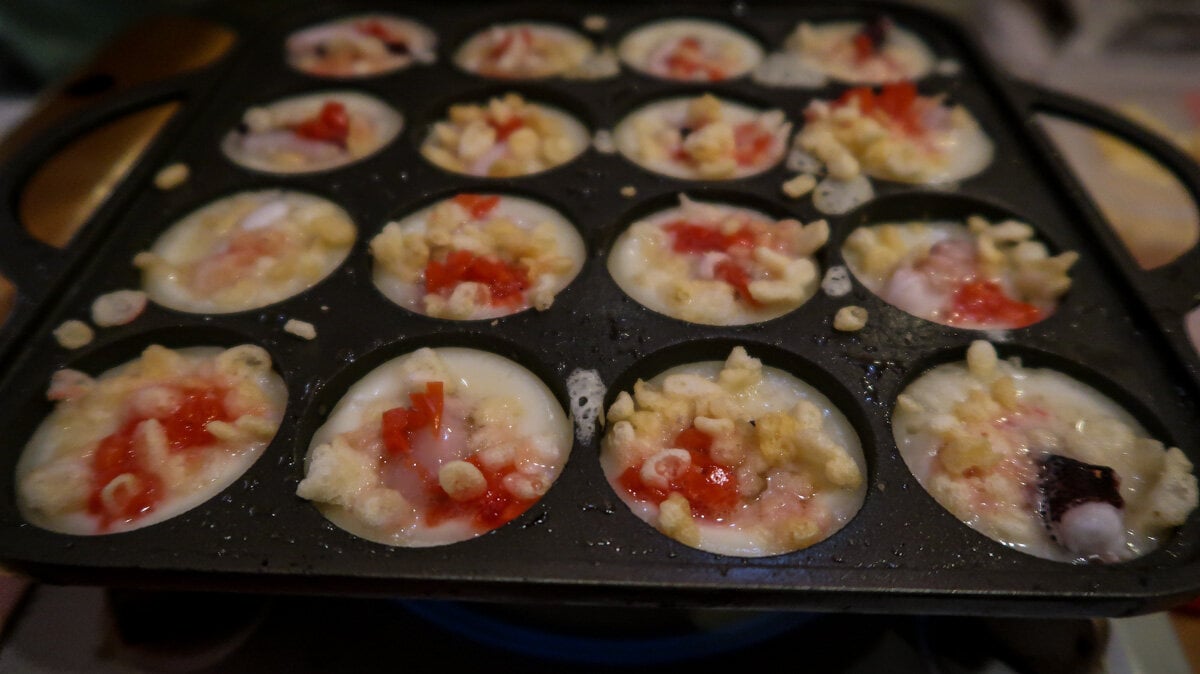
We’ve taken a lot of food tours around the world and we love eating, so we kind of consider ourselves experts in this realm. And we can say that Arigato puts on one hell of a food tour. The price tag isn’t exactly cheap, but the amount of food and the quality of service was well worth it, in our opinions.
Not only did we get to sample a ton of different foods, but we learned more in this tour — about food, culture, and history — than we did in any other tour in Japan.
Do it yourself: Book the same tour we did with Arigato, or browse the rest of their Osaka tour offerings.
Note: We were hosted by Arigato on the Shinsekai Food Tour, but all opinions are our own.
10. Discover the Retro Shinsekai Neighborhood
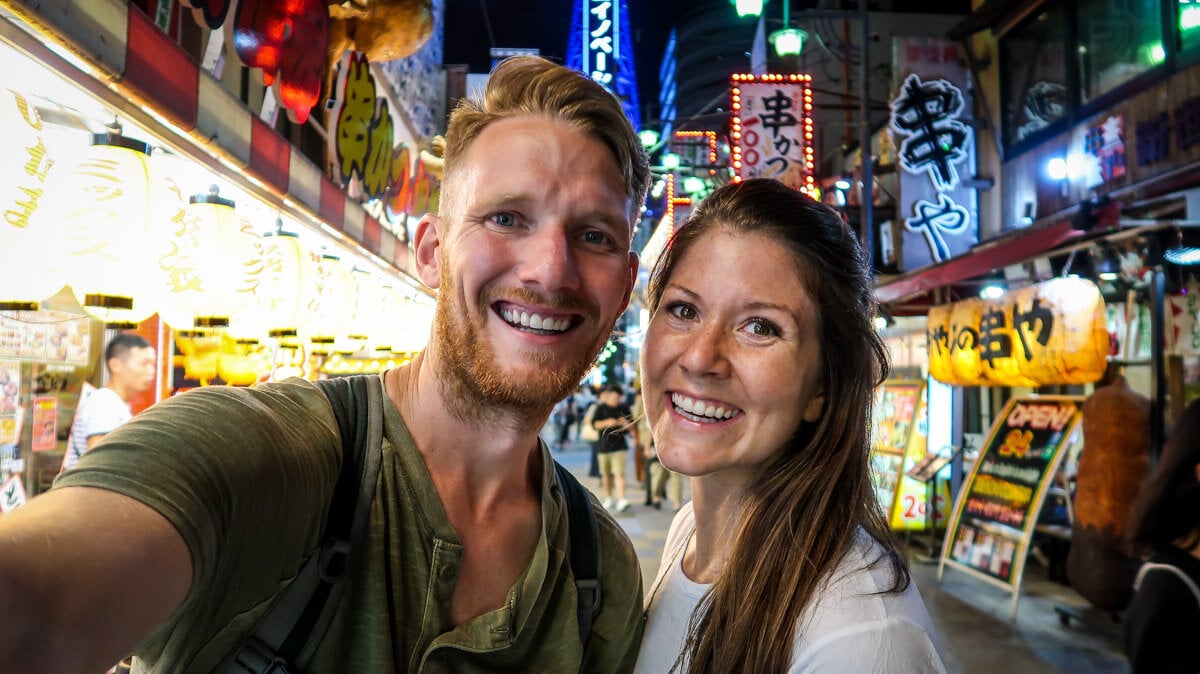
Stroll down the streets of the Shinsekai neighborhood, and with a little imagination, you’ll feel as if you’ve stepped back in time. This is arguably one of the most interesting neighborhoods in Osaka, and exploring it will show you a different side of the city than you’ll find in the modern center.
Wandering around this area might feel oddly familiar, and there’s a reason for that. The centerpiece of this neighborhood, Tsutenkaku Tower, was modeled after the Eiffel Tower, and the southern part of the neighborhood was constructed to look like Coney Island.
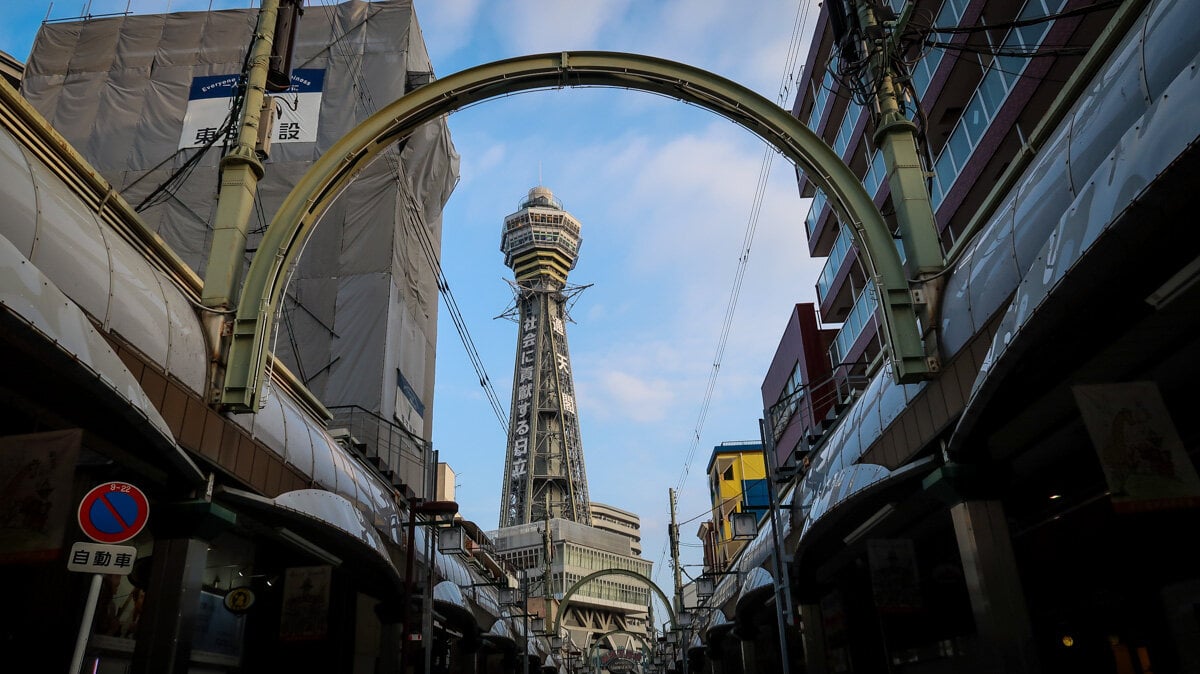
For the best atmosphere, arrive around dusk so you can see this area come alive as the sun goes down, with neon lights, loud pachinko parlors, karaoke bars, and cheap eateries.
To fully appreciate this area you have to understand the history, so we’ll give you a quickie history lesson:
Built in 1912 to showcase Japan’s prosperity, Shinsekai was modeled after Paris (with the Eiffel Tower-inspired Tsutenkaku Tower) and Coney Island. But after WWII, the area fell into decline and became known as seedy. Today, it’s seeing a revival, while still retaining its nostalgic charm.
Good to know: In years past, locals have referred to Shinsekai as being dangerous, however, that stigma is quickly changing. Although the neighborhood still retains its seediness (in a weirdly charming way!), there’s no reason to be worried about visiting Shinsekai.
Things to Do in Shinsekai
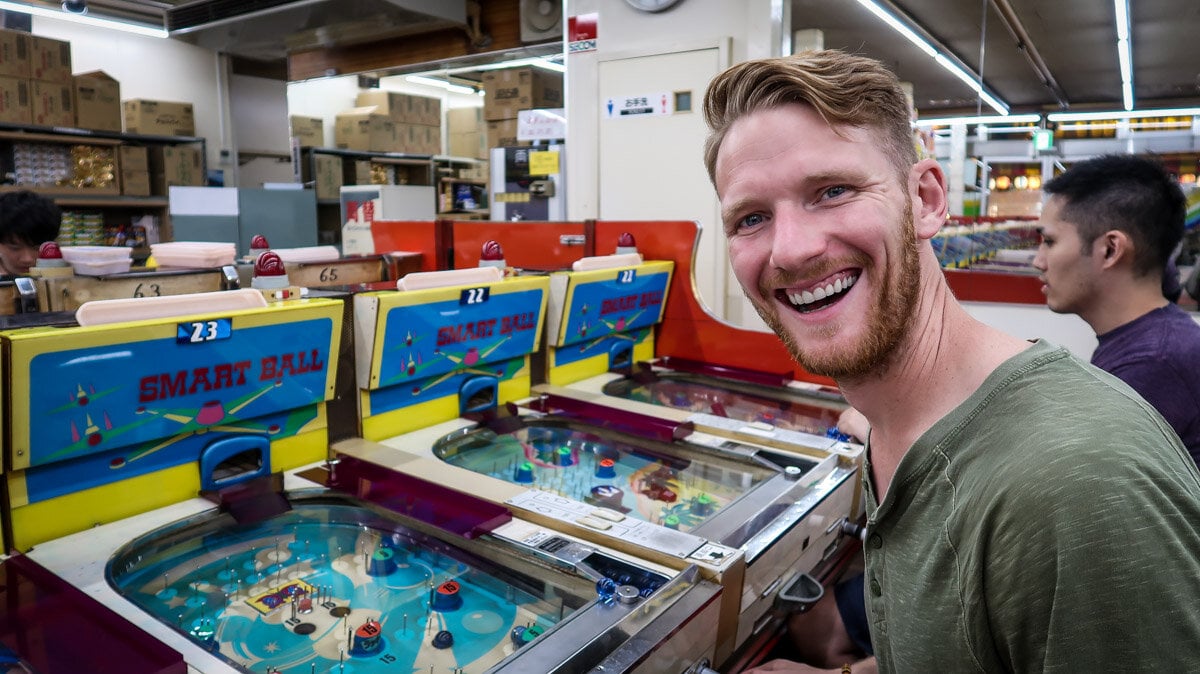
Play old school pachinko: If you want a unique place to try out pachinko, test your skills at Smartball New Star, which has a totally retro feel unlike the more modern machines you’ll find elsewhere in the city.
Get a view at the top of the Tsutenkaku Tower: Entrance costs 700 yen, and at the top there are sweeping views of the city.
Soak at Spa World: This huge public bath is divided into Asian spas and European-inspired spas, separated by gender. Entrance costs 1200 yen on weekdays and 1500 yen on weekends and holidays.
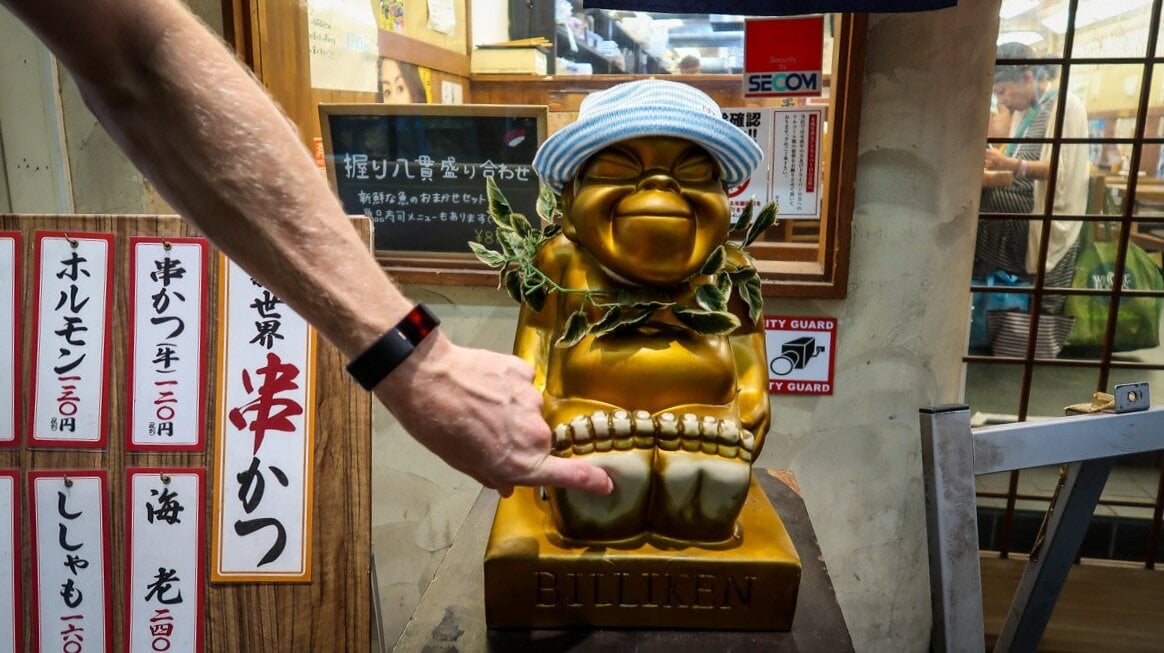
Spot the Billiken statues: You won’t have to wander far to notice statues of a cherub-like figure with a mischievous grin. The grinning “God of Happiness” is said to bring good luck if you rub his feet.
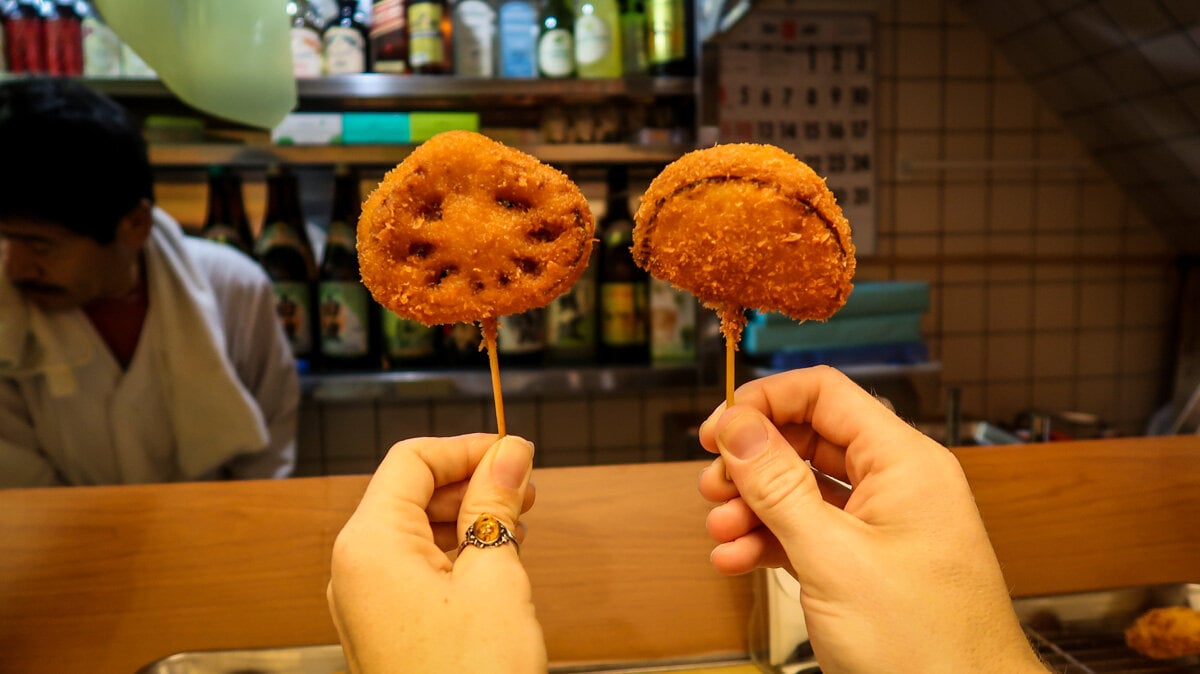
Eat kushikatsu: Shinsekai is said to be the place where kushikatsu was invented as an inexpensive yet filling food. There are tons of restaurants serving up these deep-fried meat and vegetable skewers for cheap (some starting at under 100 yen per skewer).
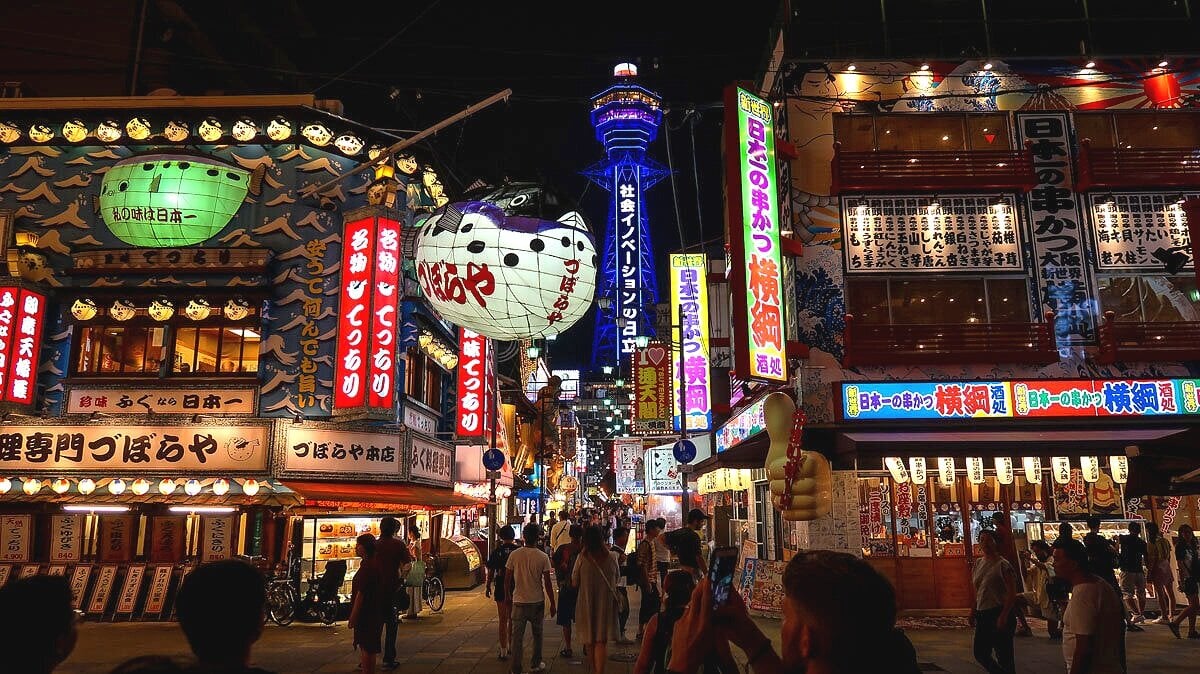
Glimpse the famous blowfish lantern: This neighborhood has a handful of restaurants that specialize in fugu, or pufferfish. It must be prepared by a highly-skilled chef because if not cut properly, it can be poisonous. This is a very expensive dish, but if your budget and curiosity allows, Shinsekai is a good place to give it a try.
How to get there: Shinsekai is a short walk from many train stations: Shin-Imamiya (JR Loop Line); Ebisucho (Sakaisuji Line); Dobutsuen-mae (Midosuji/Sakaisuji Lines).
11. Go on a walking tour
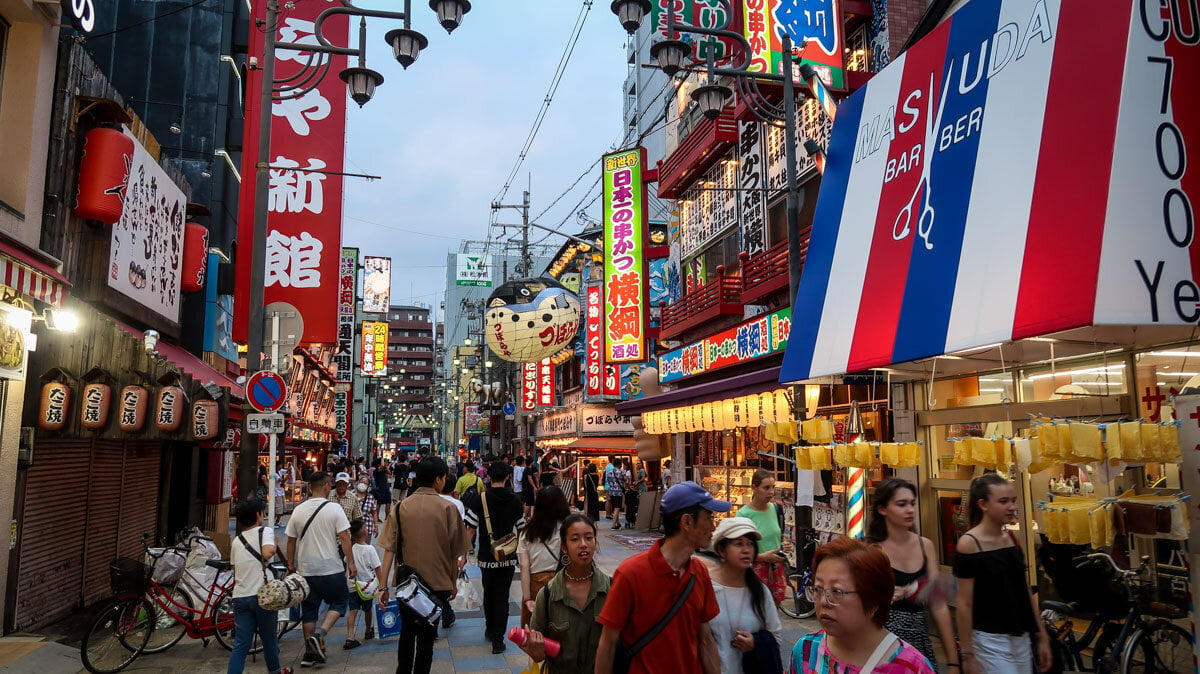
One of our favorite things to do when we travel to a new city is to take a walking tour. It’s a great way to get your bearings in a new place, get a taste for local culture and some useful recommendations.
This walking tour of the Shinsekai/Dotonbori neighborhoods comes highly recommended with great reviews.
Osaka native, Masa, is your guide for this tour, which combines a bit of history, food, and sightseeing with insider knowledge of the real Osaka—the side tourists don’t typically see.
What you need to know:
- Meeting location: Shinsekai neighborhood
- Price: from $37 USD per person
- Duration: 2 hours
What guests are saying:
“Masaaki was very enthusiastic in showing us his Osaka and patiently answered all our questions! A must do if you ever visit Osaka! Learnt a lot more about Japanese culture.” – Howard, December 2022
12. Play Pachinko
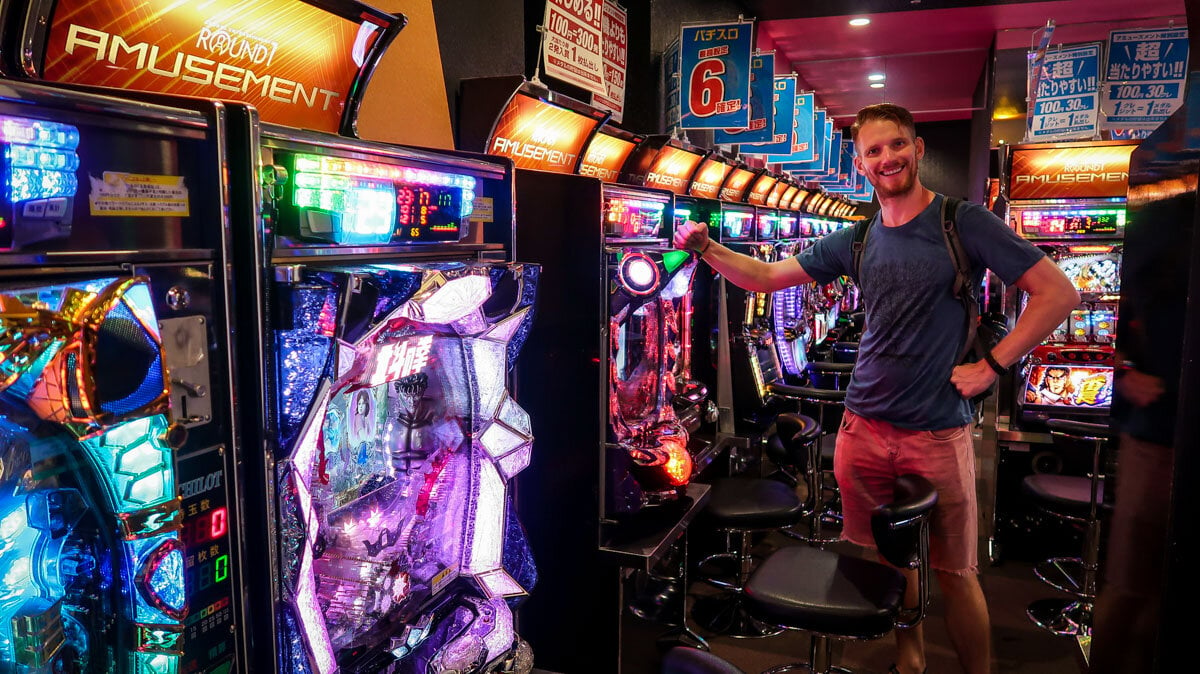
Imagine a flashy Vegas slot machine and a pinball machine had a baby—that’s pachinko. Loud, sparkly, and slightly confusing, pachinko is a popular (and bizarrely addictive) game you’ll see all over Japan, from small-town arcades to giant city parlors.
While technically not gambling (that’s illegal in Japan), it feels like it. Instead of winning money, you earn silver balls that you can trade for snacks, toys, or electronics. It kind of reminds me of the prizes at the roller rinks I went to in elementary school. Yet pachinko parlors are mostly packed with middle aged men. Strange, I know.
Honestly, we didn’t totally get the hype, but it’s one of those quirky Japan experiences worth trying at least once. It’s cheap, and you’ll find pachinko parlors all over places like Dotonbori.
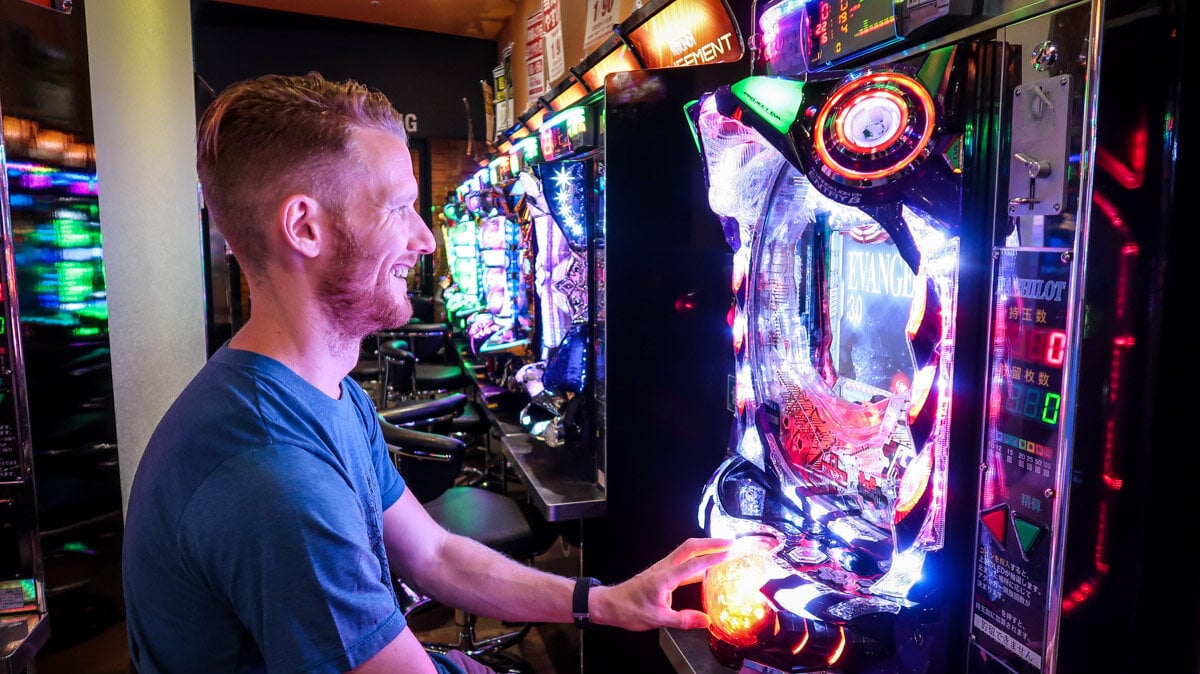
Wander through the streets in Dotonbori and you’re sure to find a pachinko parlor (or 10), or stop into one while exploring some of the less touristy neighborhoods in Osaka. Just look for large signs that say “pachinko”!
Round 1 is a spot that’s popular with locals, and is conveniently in the Dotonbori area. In addition to pachinko, you’ll find lots of other arcade games, bowling, and even ice skating.
Oh, and while we’re on the topic, here are the instructions for playing this game. Hopefully you won’t be quite as confused as we were our first try!
Pachinko instructions:
- Insert money and press play (玉貸).
- Turn the round lever, which shoots out small metal balls. The further you turn the handle, the stronger the balls will shoot. Start by just barely turning the lever until you get a feel for it, and keep it turned so balls continue to shoot.
- Aim the balls at the gaps in the pegs. Your goal is to make them go into the small hole in the center of the game board. Tip: Many players claim that the top left corner is the best spot to aim.
- When you get the ball into the proper hole, you will be rewarded with a celebratory “ding-ding-ding” and more balls to play with (or cash in for prizes).
13. Strike a pose in a Purikura (aka Japanese photo booth)
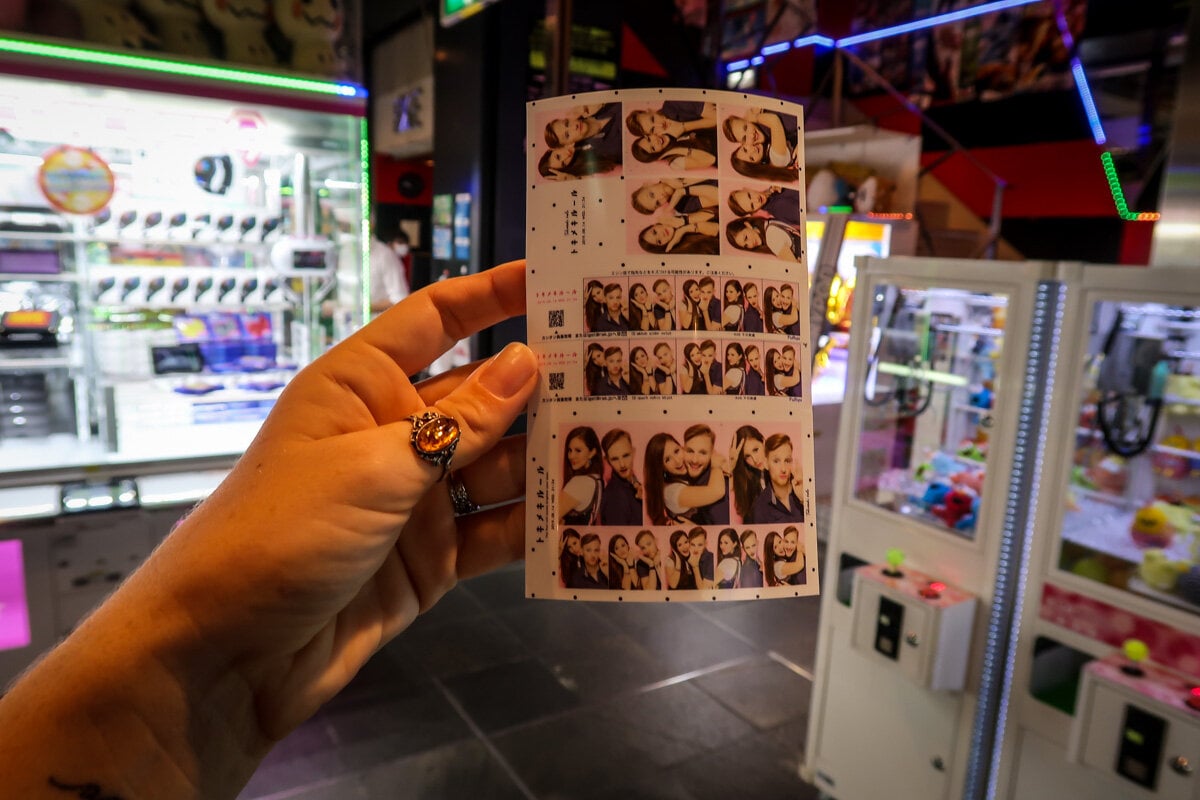
Just like many things, Japan does photo booths cuter than the rest of the world. Purikura, or Japanese photo booths, don’t just print off a strip of 4 photos and call it good. No, they go above and beyond.
After striking a handful of poses, you will exit the photo booth. And this is where the fun begins…
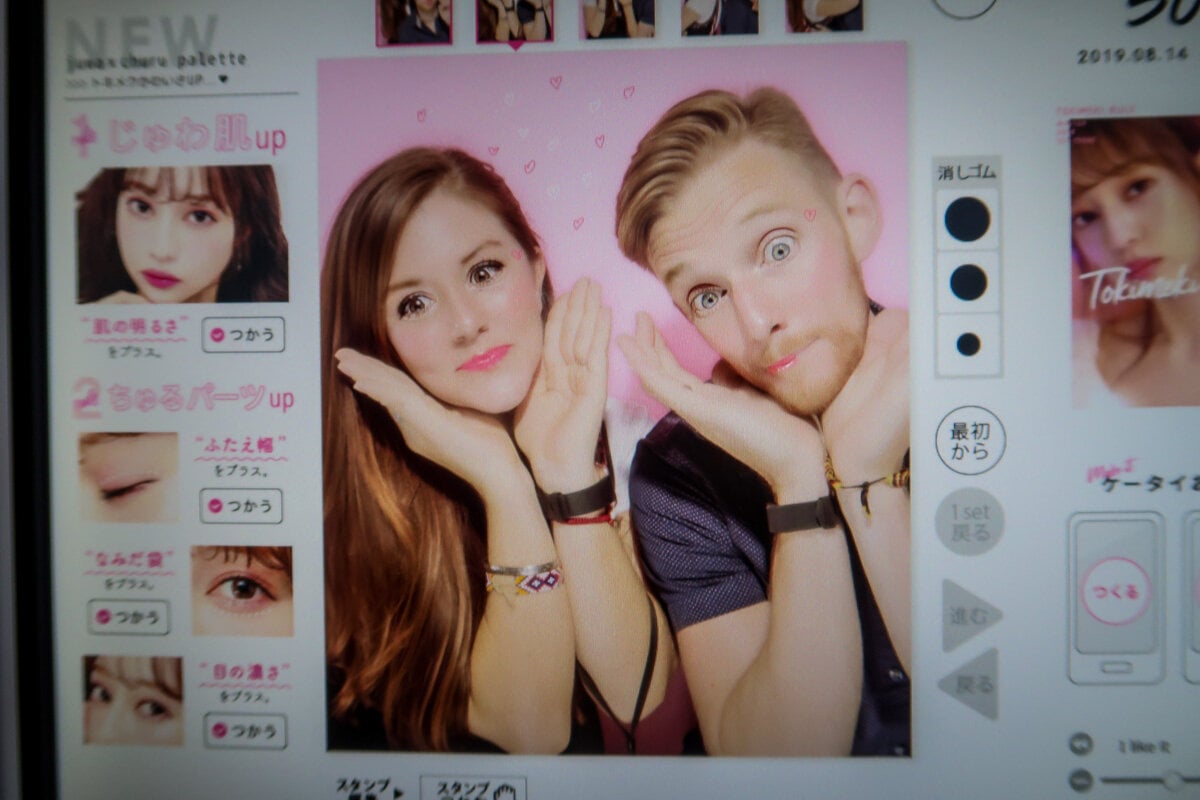
Choose your favorite photos, then go wild with edits—enlarge your eyes, add makeup (Ben had way too much fun with this!), slap on some stickers… all before the timer runs out. It’s fast, silly, and totally over-the-top.
In the end, you’ll get a fun (and cheap) souvenir. Just note: the photos are small, and you only get one print, so you might want to go again if you’re with a friend or partner.
Heads up: while they say you can get digital copies, you’ll likely have to pay extra to access the unwatermarked versions. Womp womp.
Cost: Prices may range, but the one we did cost 400 yen.
14. Ride the Tempozan Ferris Wheel
Head to Tempozan Harbor Village for epic views from one of the world’s tallest ferris wheels. When it opened in 1997, it held the record for height—and even today, the 17-minute ride offers stunning views of Osaka Bay, the Akashi Kaikyō Bridge, Mount Ikoma, and the Rokko Mountains.
Hours & Cost: The ferris wheel is open from 10:00 a.m. to 10:00 p.m. (last entrance is at 9:30 p.m.) and tickets cost just 800 yen (about $6 USD) to ride.
15. Catch a baseball game
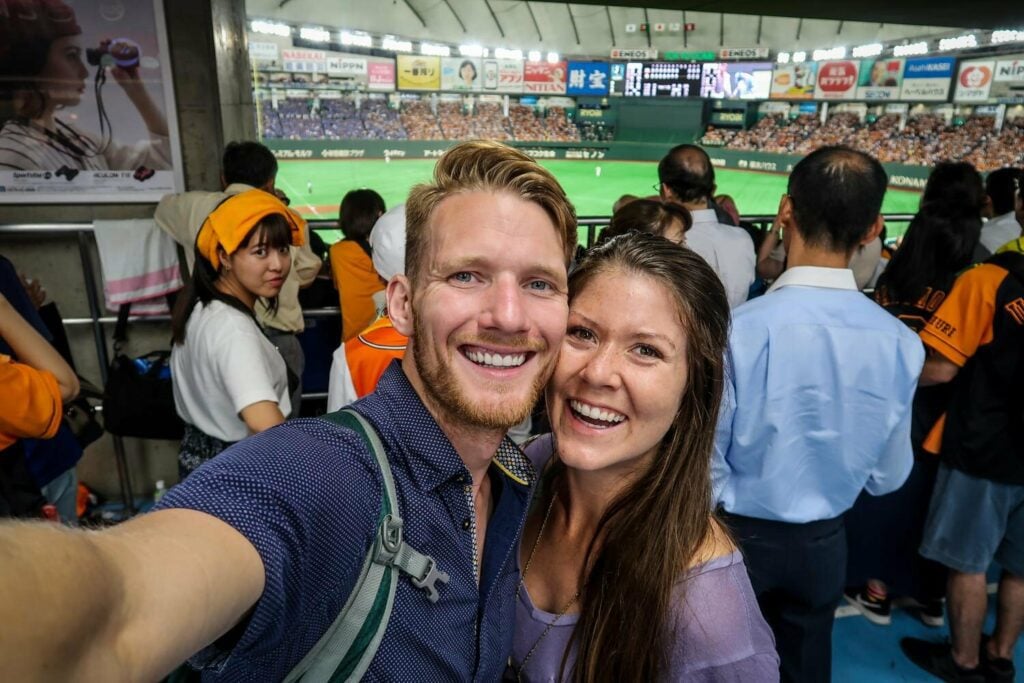
Take me out to the Japanese ball game… not a tune you’d expect to hear this far from the United States, amIright?
In fact, baseball has been a popular pastime in Japan since post-WWII time. The Hanshin Tigers are one of Japan’s oldest baseball clubs, based in Osaka and consisting of players from Japan and all over the world.
You can catch the Tigers playing at Hanshin Koshien Stadium just outside of central Osaka. Check out the team’s official website (in English!) to view their schedule and purchase tickets.
16. Snap a photo in front of the Namba Yasaka Shrine
Just an 8-minute walk from Nankai Station, this unique shrine in Osaka’s Namba neighborhood is famous for its giant lion head-shaped building and seasonal cherry blossoms.
Built in 1975 on the site of temples destroyed in WWII, the lion’s mouth is said to “swallow” evil spirits and bring good luck—especially for school and business success.
17. Relax at a public bath
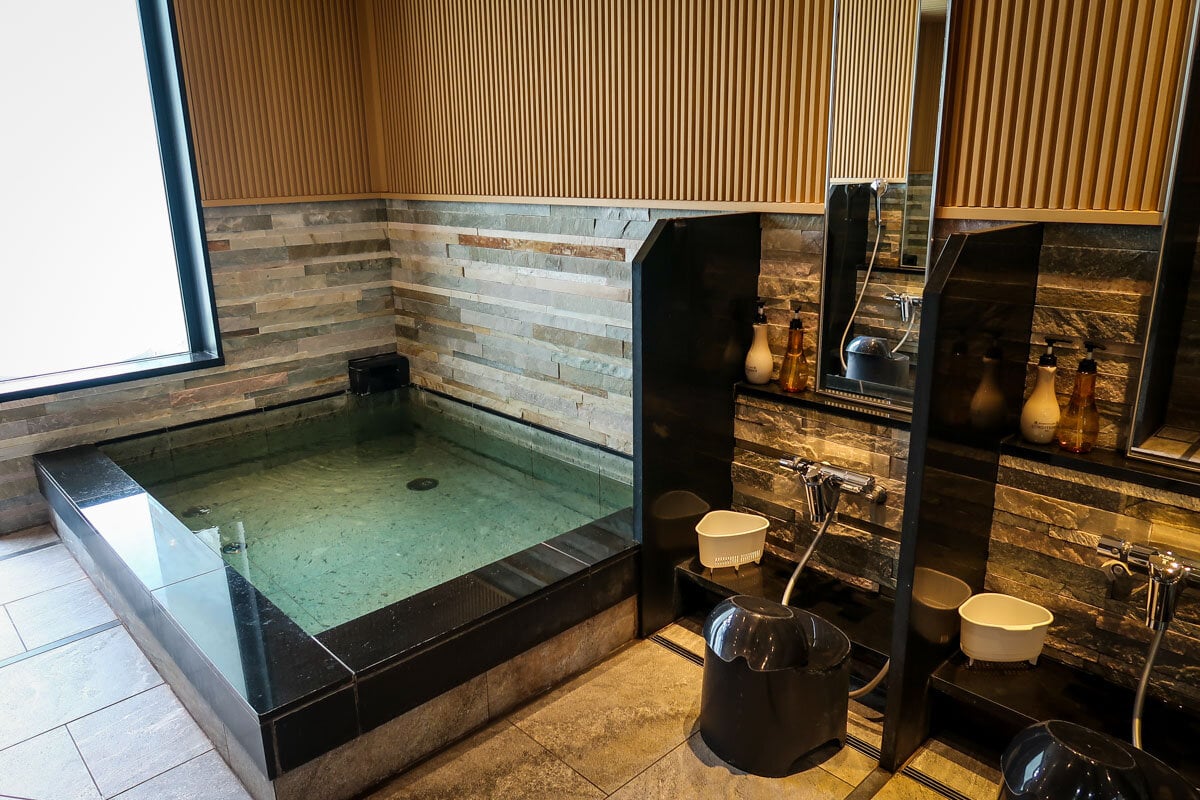
If dropping your clothes in front of strangers sounds like something that would be out of your comfort zone, you’re not alone.
However, onsens and public baths are a huge part of Japanese culture, and are part of most people’s weekly routines. So if you think you can handle it, visiting one is a unique (and maybe even enjoyable!) experience.
Once you get over the whole being naked in public thing — yeah, it used to be of my nightmares too! — you’ll find that nobody else actually cares that you’re naked. And after a while you might even find it relaxing — gasp!
Here are a couple things to keep in mind at public baths:
- If you have tattoos, check their policy ahead of time. Some are lenient while others are strict.
- Baths are typically gender-separated, with the exception of some foot baths. If you come with a partner of the opposite sex, come up with a meeting time.
- You must shower before you get into the bath.
- Some of the larger baths are open almost 24 hours. It’s not uncommon for them to close for a couple hours from 8-10 a.m. for cleaning, but to be open the rest of the night.
There are a lot of public baths and onsens in Osaka. Each neighborhood has their own “local bath”. But if you want to have several different places to soak, Spa World is a good option!
→ Related: Avoid awkward moments by brushing up on Japanese etiquette before you travel!
18. Have drinks at a speakeasy
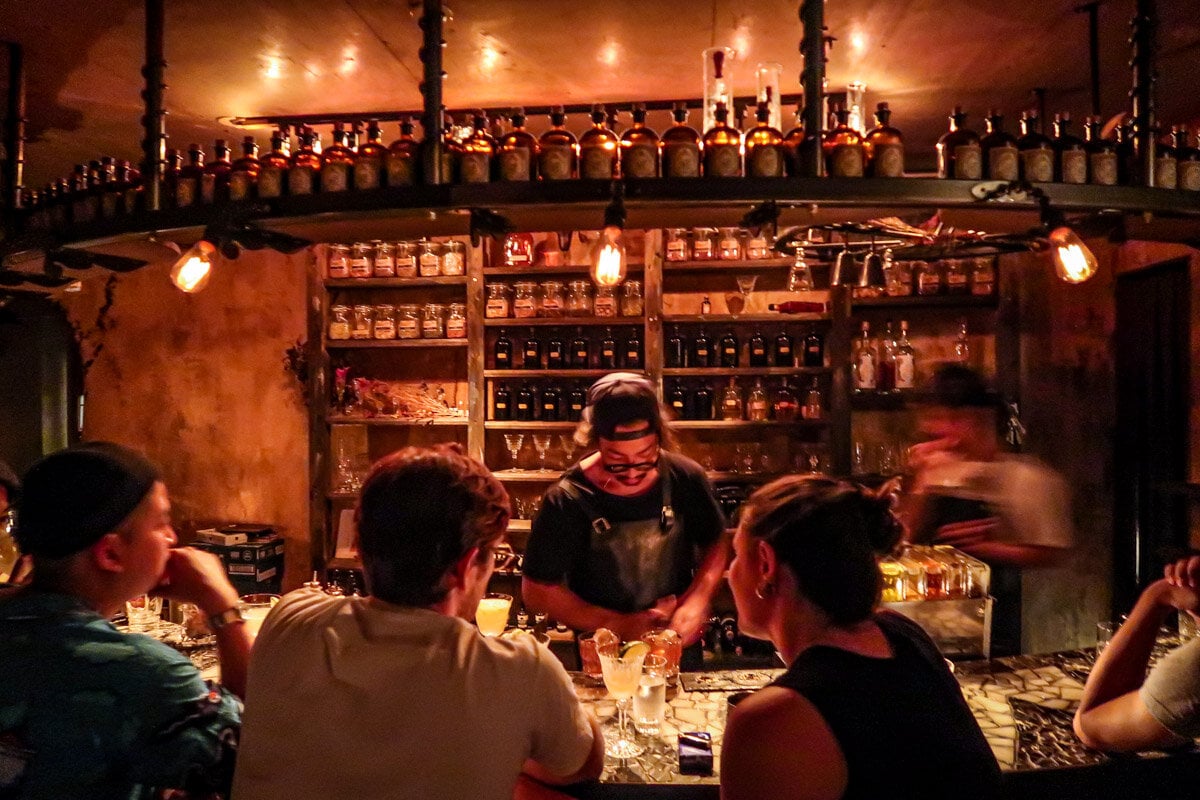
We’re going to let you in on an Osaka secret, so listen up…
There is a super cool speakeasy bar hidden in a residential building that you’d never know was there if you were just walking past. The windows are boarded up and the stairwell looks uninviting.
But if you do make it to this spot, you’ll find a dimly lit space with just 20 seats and a hushed atmosphere that lets you know you’ve found something special.
Hint: You’ll find it on the 5th floor, and getting there requires the use of a trap door…
There is no menu. Instead, you’ll tell the bartender what flavors you like (spicy, fruity, smoky, etc.) as well as your preferred liquor, and be prepared to be impressed.
We loved everything about this place. Except the cigarette smoke, which is pretty thick. But that’s just how it is everywhere you go in Japan.
We almost don’t want to spill this secret, but it’s such a cool spot that we couldn’t help sharing it with you!
How much does it cost? As we mentioned, there is no menu. So you’re kind of ordering blindly without knowing the price of the drinks. To give you an idea of what to expect, our total bill for 2 drinks (one with gin and one with whiskey) was 2700 yen ($25.50 USD).
19. Learn to roll your own sushi
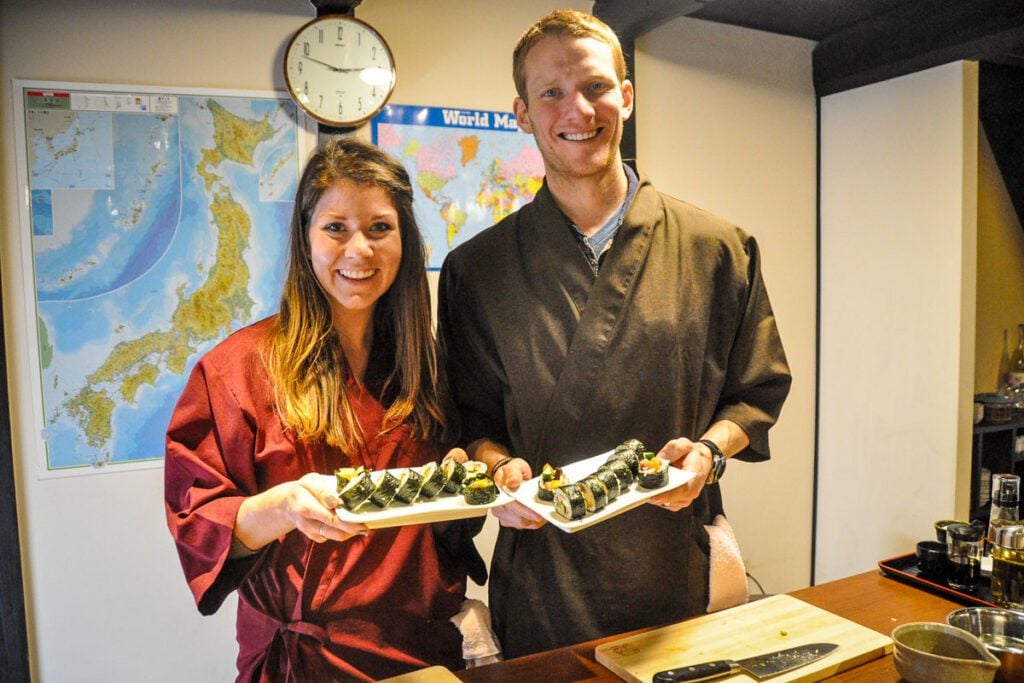
Sometimes referred to as the “kitchen of Japan,” Osaka is a great place to dive into the Japanese food scene. This unique sushi experience will teach you how to make deco-rolled sushi, which of course you get to eat afterwards!
Your host Toko is well-practiced in the art of deco-rolled sushi, which is sushi with cute designs like animal faces in case you were wondering (don’t worry—I didn’t know what it was either!). She has been running a cooking school out of her home in Osaka for over 2 years.
During the 2 hour experience, Toko is happy to answer any questions you have about the art of sushi making as well as about local life in Osaka.
What you need to know:
- Meeting location: Nakazakicyo neighborhood
- Price: from $30 USD per person
- Duration: 2 hours
What guests are saying:
“My group of 4 people had an amazing time making sushi with Toko. We all had way more fun than we expected and the sushi was really good. I would recommend everyone try this experience while in Osaka.” – Antonio, March 2020
20. Participate in a traditional tea ceremony
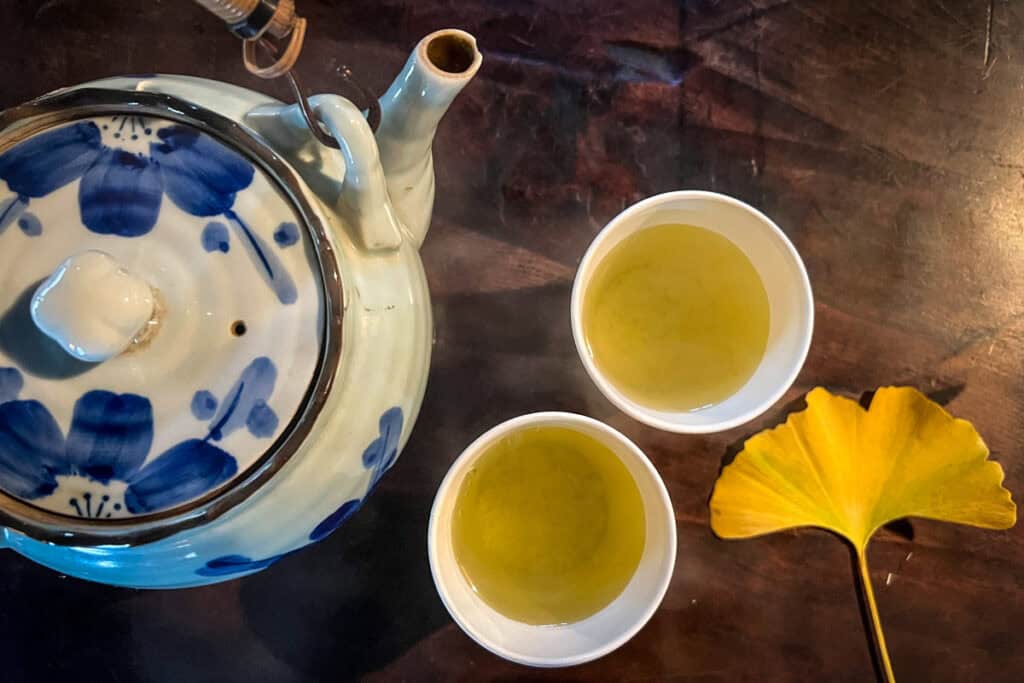
Many travelers come to Japan hoping to participate in a traditional tea ceremony and Osaka is a great place to do so. In this traditional experience, you’ll first be guided to pick out a traditional kimono (in the particular style for men, women, boys or girls) so you can dress the part.
The ceremony commences in an ancient-style Japanese tea ceremony room where you’ll make your own Matcha tea and learn some of the rituals while discussing Japanese culture. Photos are encouraged after the ceremony.
What you need to know:
- Meeting location: Osaka
- Price: from $49 USD per person
- Duration: 1 hour
What guests are saying:
“A truly wonderful experience! The tea ceremony was a great insight into Japanese history and culture and all the tea masters were friendly and thoughtful. A must do if you are in Osaka!!” – Mia, January 2020
21. Stay in a capsule hotel
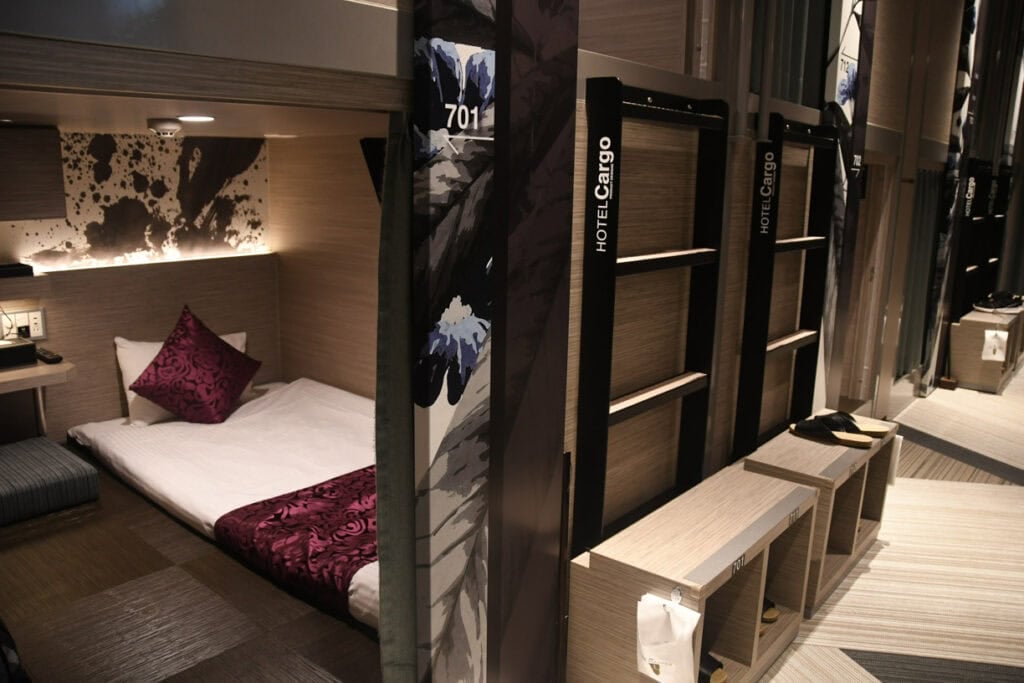
Originally created in the 1970s for businessmen needing a cheap place to crash, capsule hotels have become a uniquely Japanese experience that many travelers try at least once.
The pods are just big enough to sit or lie down (not stand), which may not be ideal if you’re claustrophobic. Most have shared bathrooms, gender-separated floors, and provide toiletries and pajamas.
While usually less social than hostels, some newer capsule hotels are surprisingly stylish and comfortable.
Fun fact: The very first capsule hotel in the world was in Osaka, so this city is the perfect place to try it for yourself.
Where we stayed: Hotel Cargo
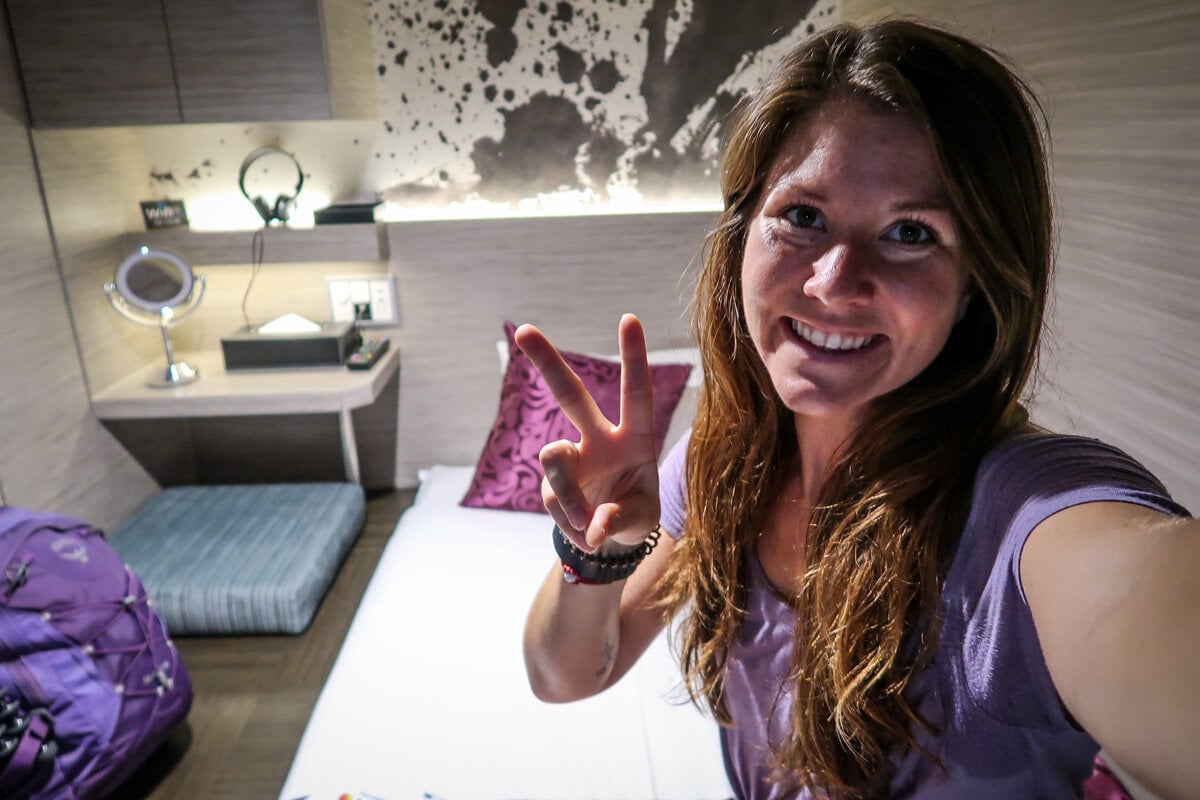
Staying in a capsule hotel is one Japanese experience we figured we should probably try for ourselves. So even though it meant that we would need to spend the night apart — I know, I know, we’re gross and mushy-gushy! — we decided to book 2 separate capsules.
We opted to pay a bit more for one of the higher-rated capsules, and we were impressed with how comfortable it was.
The pods at Hotel Cargo are designed like tiny rooms: You can’t stand, but otherwise it seems like everything you’ll have in a normal hotel room: vanity, tv, trash can, even a mini closet. And the bathroom and showers have all the toiletries you could need.
22. Cup Noodle Museum
This museum is free to enter, and is one of those “only in Japan” experiences. Explore the different exhibits that range from the history of cup noodles, to the manufacturing process, to different versions you can find around the world, to a Cup Noodle theater!
And for 300 yen, you can even make your own Cup Noodle by designing the packaging and choosing your own toppings and flavorings.
While it’s certainly not the freshest ramen you’ll have in Japan, it is perhaps the only one that’ll make it home in your suitcase as an edible souvenir.
More info: For opening hours and directions, check out the Cup Noodle Museum website.
23. Drive a Go Kart around Osaka
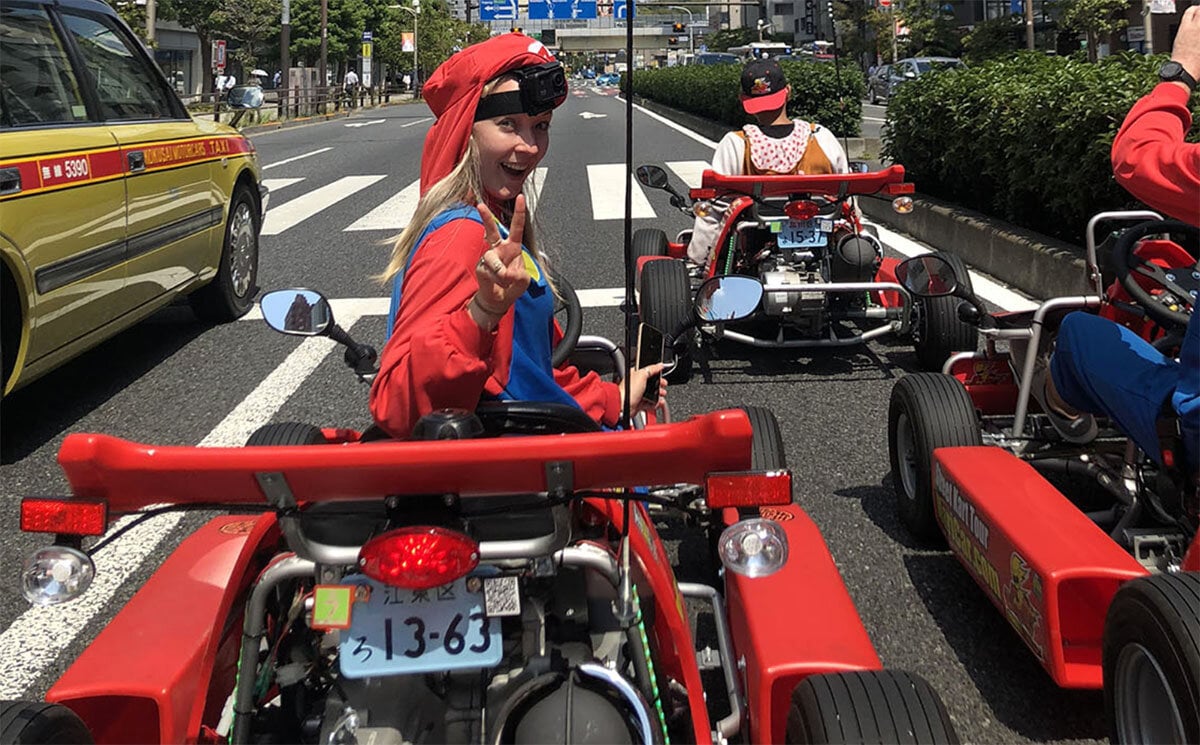
Can you imagine anything more ridiculously Japanese than dressing up in costume and jumping into a go-kart to drive around the city streets?! This experience turns your 1990’s Mario Kart dreams into real life, and is a unique way to see the city of Osaka, to say the least.
This is a popular thing to do in Tokyo, but if you’re short on time in Japan’s largest city, Osaka is another excellent place to have this quirky only-in-Japan experience.
Important to know: Be sure to bring your international driver’s license with you, as you will not be allowed to do this experience without it. Ben had his, but sadly I didn’t have one on this trip, so we had to skip this experience.
24. Visit Universal Studios Osaka
Let your inner child loose with a visit to Osaka’s very own Universal Studios.
We’re kicking ourselves that we didn’t make it here because we’re huge Harry Potter fans! So next time we’re in Osaka and have a day to spare, we’ll definitely make it to The Wizarding World of Harry Potter.
And while we’re there I suppose we should check out some other attractions, like Spider Man and Jurassic Park… that is if we can peel ourselves away from Hogwarts and butter beer!
Insider Tip: We’d recommend getting your tickets in advance so you can skip the ticketing queue when you arrive. Just show your e-voucher and pass right through the entrance!
Cost of tickets at the door:
- ¥7,400 ($68 USD) for adults
- ¥5,100 ($47 USD) for children
- ¥6,700 ($62 USD) for seniors (65 years and over)
25. Go for a unique mountain hike and trout fishing experience
If you’re looking for a unique experience to immerse yourself in nature while in Osaka, this may be just the thing for you.
This highly rated mountain hike and trout fishing experience takes you off the beaten path (literally!) into the wilderness of Mt. Kongo outside of Osaka. During the 2 hour hike, you’ll come across 3 waterfalls, cross a beautiful creek and experience some climbing rocks.
Enjoy the views and a sacred template at the summit before heading back down to try your hand at trout fishing. A local restaurant will prepare whatever you catch for a late lunch before you head back to Osaka.
What you need to know:
- Meeting location: Osaka
- Price: from $67 USD per person
- Duration: 8 hours
What guests are saying:
“This was absolutely my favorite experience in Japan so far. The views were so beautiful and it was a much needed change of pace from the bustling city… Kazuki is a very thoughtful guide and kept a nice manageable pace for the group. I would highly recommend to anyone who enjoys hiking, beautiful forest views, and local food.” – Jessica, November 2022
26. View Osaka from above
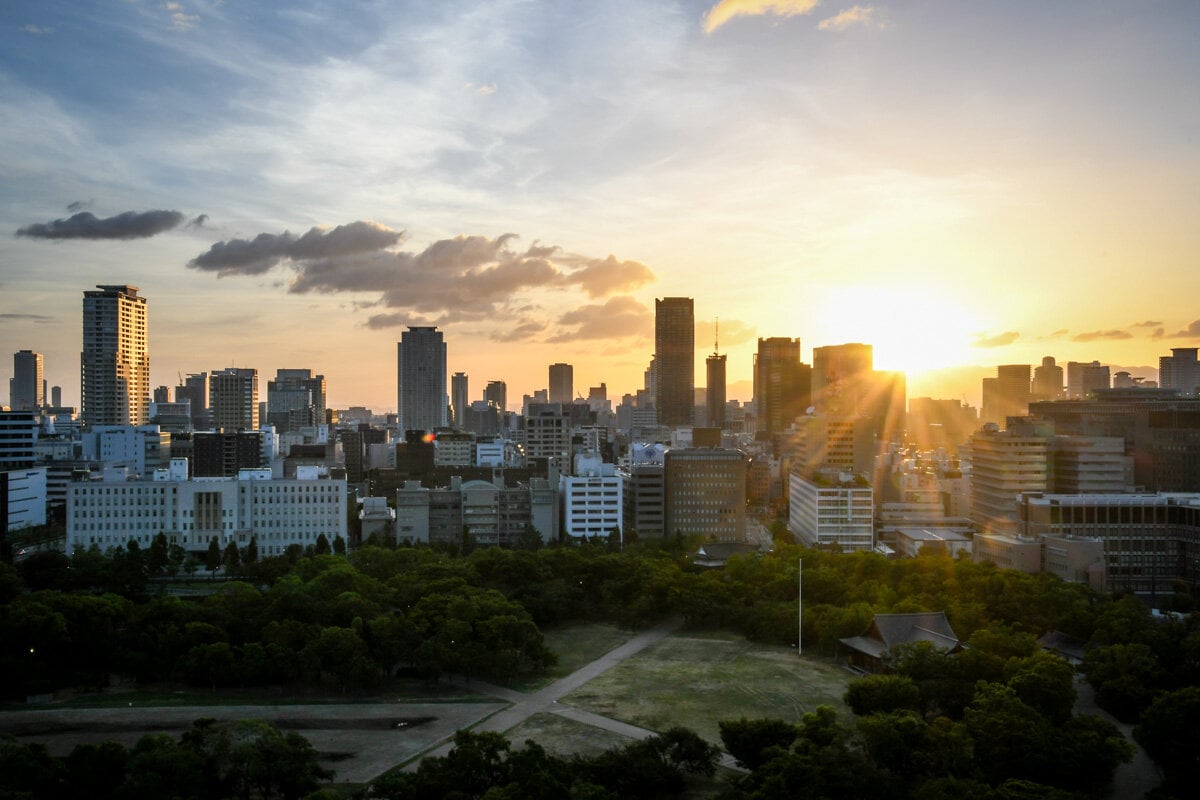
If you want to see Osaka from above, there are two very famous views of this city.
- Abeno Harukas
- Umeda Sky Building
At dusk you can watch the sun start to set and the lights turn on in the city, which would be a pretty spectacular site. Although, this is one of the more busy times from these viewpoints.
We decided to skip this as we got a pretty darn good view from the top of the Osaka Castle. Plus, we didn’t feel like paying 1,500 yen each for a view.
27. See a comedy show
We’re huge fans of comedy clubs, and had we known about ROR Comedy Club before our trip, we definitely would have made it here. (We’re kicking ourselves for missing it!)
This comedy club features local and international stand up comedians, and all shows are in English.
The reviews online are fantastic, and tickets are very affordable:
- Regular ROR shows: ¥1,000 ($9.22 USD)
- Open Mics: ¥500 ($4.61)
- Dinner, 2 Drinks & Show Set: ¥3,500 ($32.26 USD)
If you’re visiting Osaka and love to laugh, do yourself a favor and reserve your tickets now (you pay at the door). And if you do go, shoot us a message and let us know how it is!
Shows are Tuesday, Friday and Saturday nights.
28. Visit the Mozu Tombs
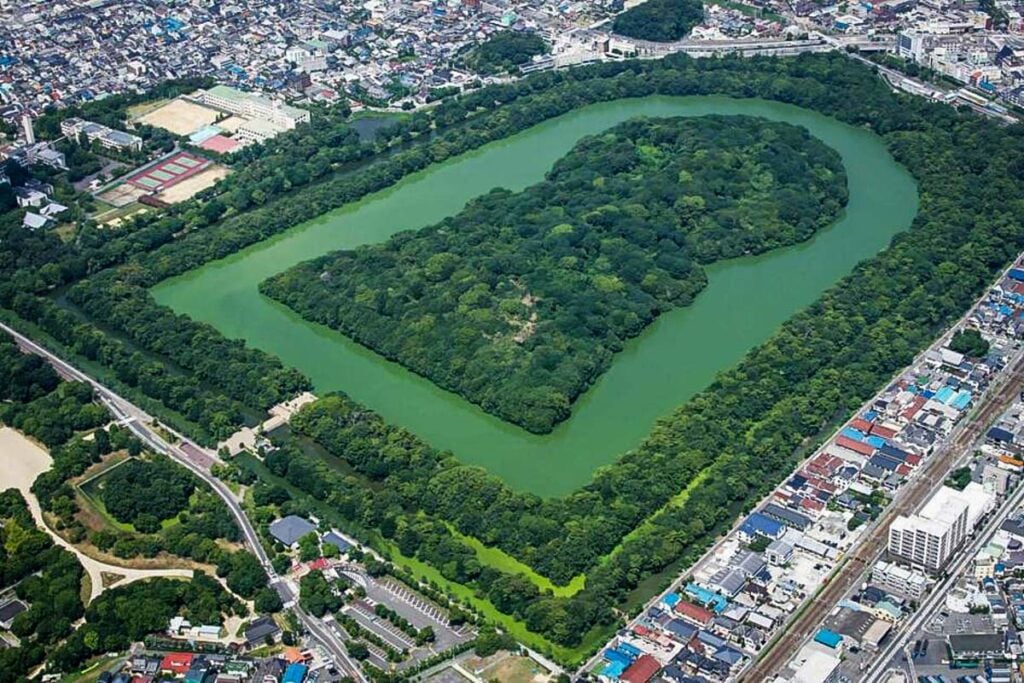
Located in Sakai, within the Osaka prefecture, the Mozu Tombs are a cluster of Japanese megalithic tombs. The large mounds of earth are mostly covered in trees in unique keyhole shapes with moats around the perimeter.
The site was designated as a UNESCO World Heritage Site in 2019.
The tombs were constructed in the 4th to 6th centuries for the ruling elite. The largest of the Mozu Tombs is believed to be the resting place of Emperor Nintoku and is Japan’s largest grave at 800 meters long by 600 meters wide.
29. Visit the unique bowing dear of Nara
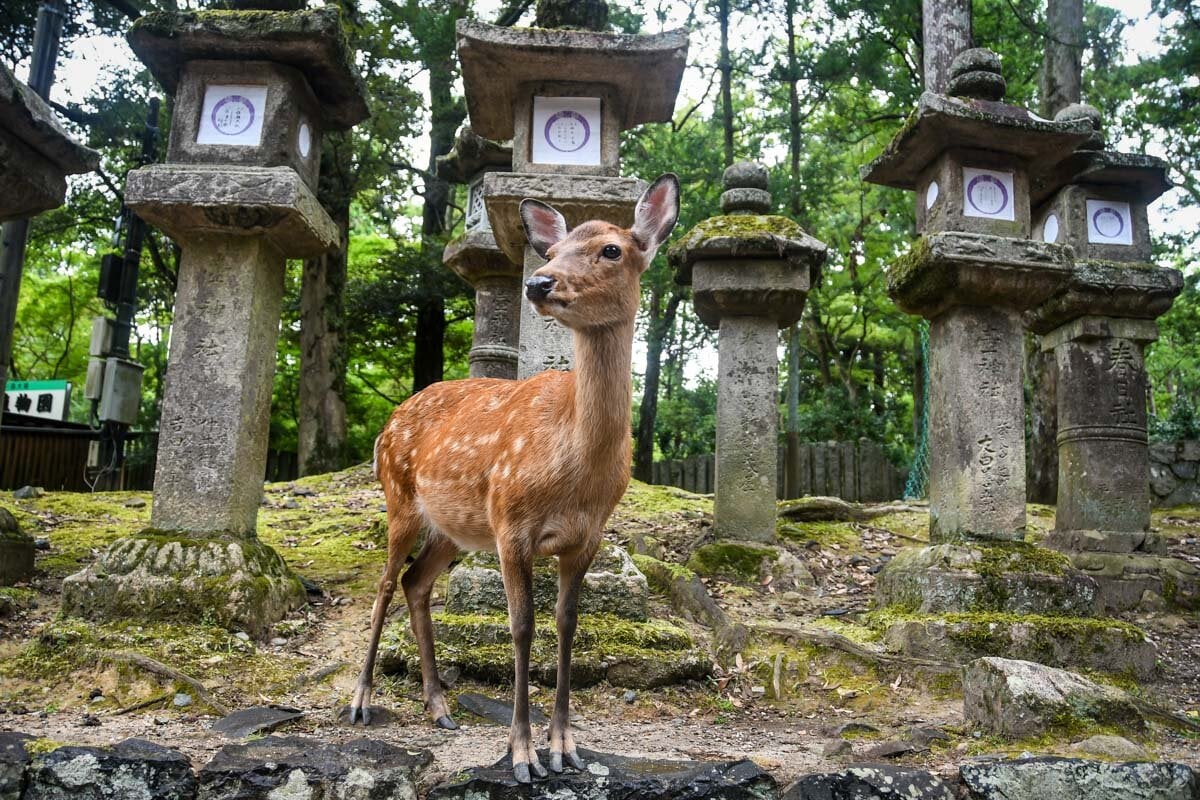
Just 45 minutes from Osaka, Nara (formerly one of the ancient capitals of Japan) is known for its friendly Sika deer that roam the city’s parks and temples. Once thought to be sacred messengers, these deer are a must-see!
If you’re planning a visit, check out our complete Nara day trip guide, which includes a detailed itinerary, where to find the best temples, and more. It’s the perfect way to experience all the highlights in one day!
30. Take a day trip to Hiroshima
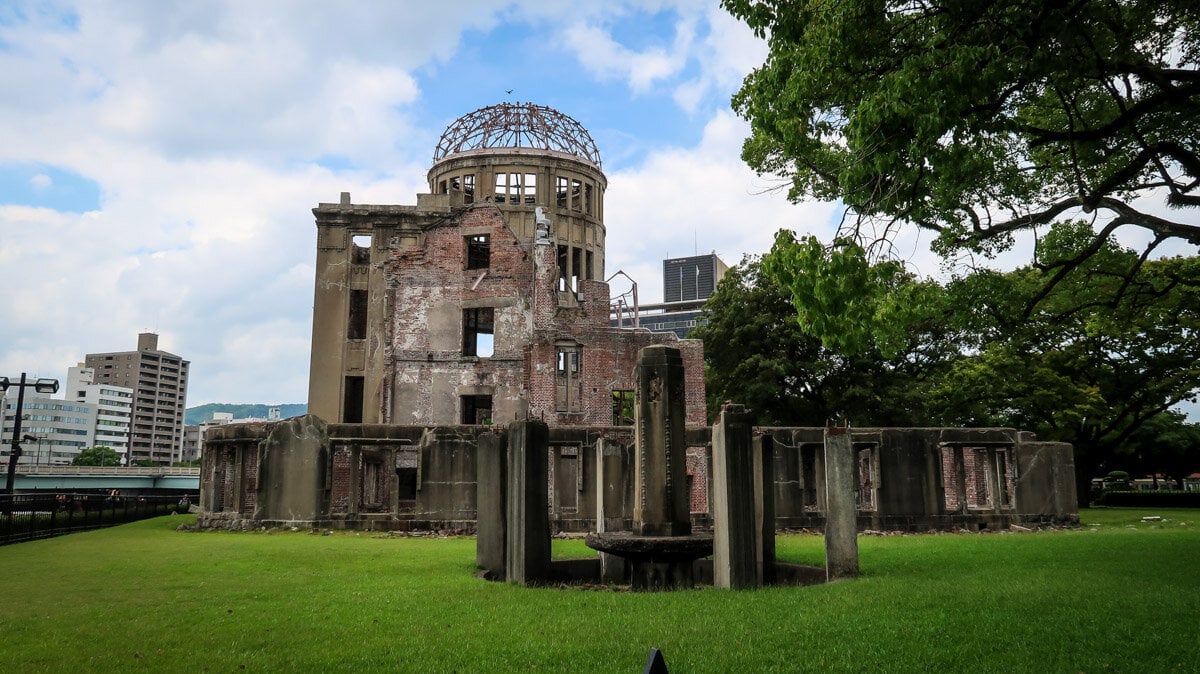
Just 1 hour and 40 minutes from Osaka by Shinkansen (and covered by the JRail pass!), Hiroshima makes for a powerful and memorable day trip.
We put together a detailed Hiroshima day trip guide with everything you need to know — from visiting Peace Park and the Atomic Bomb Dome to tips for exploring Miyajima Island and trying Hiroshima-style okonomiyaki.
If you’re short on time but still want to make a meaningful visit, this guide will help you plan the perfect day.
Osaka Map: Our favorite spots!
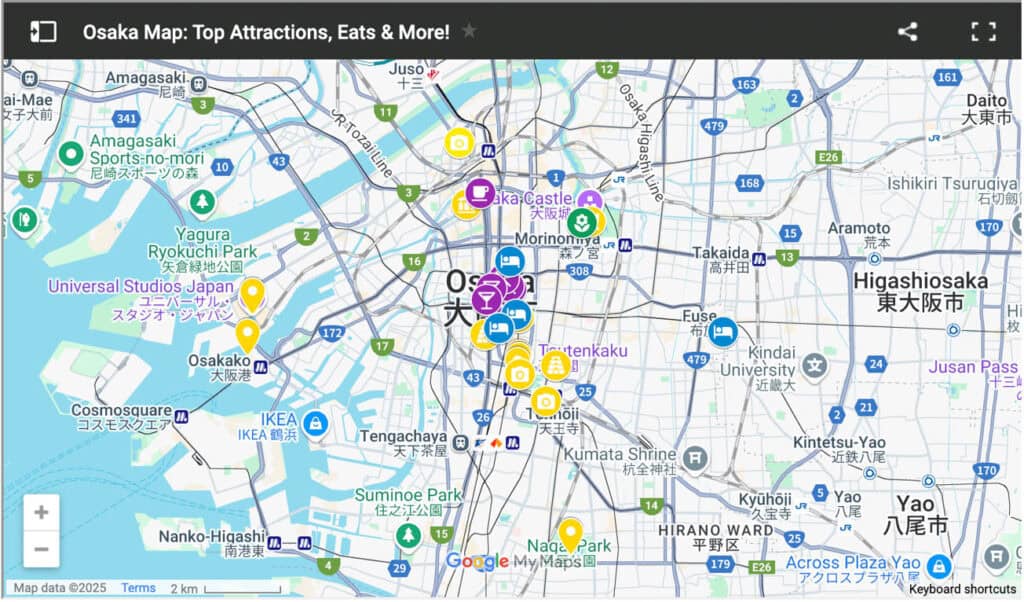
Click on the map and enter your email to gain access to our custom Osaka Map. It’s filled with 100+ custom pins with everything on this list, plus our favorite restaurants, hidden gems and more!
Perfect Osaka itinerary
Want your Osaka itinerary planned for you? No problem! We did the legwork and came up with what we think is the perfect route for a 2-day Osaka itinerary for your first visit.
First timer’s guide to Osaka
If this is your first time visiting Osaka, you’ll want to read our First Timer’s guide which is packed with helpful information like how to get around and where to find the best eats.
Day trips from Osaka
If you’re looking to combine your trip to Osaka with a few other places, or you’re simply in search of nearby adventures, you’ve got a ton of options.
There are so many places near Osaka that you can go for a quick adventure or a weekend getaway, so we decided to do an entire round-up of the best day trips from Osaka.
Plan your trip to Japan
After 3 trips (and counting!), we’ve fallen head over heels for Japan—and we’ve created TONS of resources to help you plan your dream trip. Start with our Ultimate Japan Travel Guide and be sure to check out these helpful articles:
- First time? Our Japan Trip Planner walks you through everything you need to know.
- Use our Japan Rail Pass guide to determine if getting a train pass is optimal for your trip.
- Here’s our curated list of the best things to do in Japan—from iconic sights to once-in-a-lifetime experiences.
- Not sure where to go? Our Japan itinerary ideas will help you map it all out.
- Foodies, rejoice! This guide to what to eat in Japan will have you drooling before you land.
- This guide to what to wear in Japan (and what not to wear) will help you blend in.
- Use our ultimate Japan Packing List to make sure you don’t forget anything.
- Before you go, brush up on these essential Japan travel tips (including major do’s and don’ts!).
- Avoid awkward moments by brushing up on Japanese etiquette.
Still have questions? Drop us a comment—we LOVE helping travelers plan unforgettable trips to Japan!
Perfect Japan itinerary
Want the perfect itinerary planned for you?
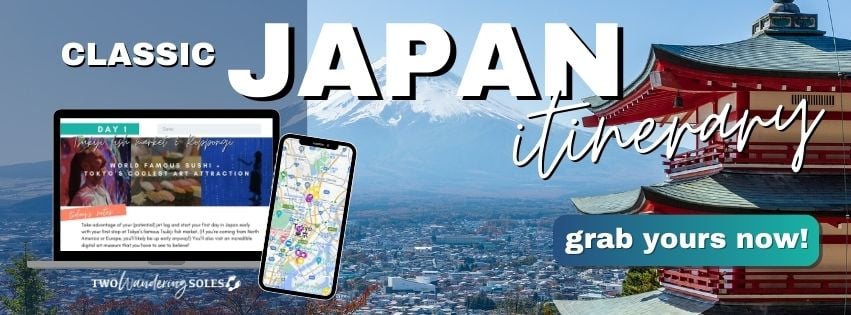
If you don’t have a ton of time to spend planning your Japan itinerary (or you just don’t find travel planning fun), we’ve got something you might be interested in…
We created the ultimate done-for-you Japan itinerary that is packed full of all sorts of tips we’ve gathered from 3 trips to Japan as well as literally hundreds of hours of research (no exaggeration).
We have both an off-the-beaten path route as well as a classic itinerary that hits the top attractions (perfect for your first visit to Japan!).
Don’t miss your chance to grab our Osaka map!
Get our custom Osaka map sent straight to your phone! We loaded this map with all our favorite restaurants, sights, hidden gems, and more, so you can make the most of your time in Osaka.
Just enter your email and we’ll immediately send you access instructions!
Save this article on Pinterest for later!
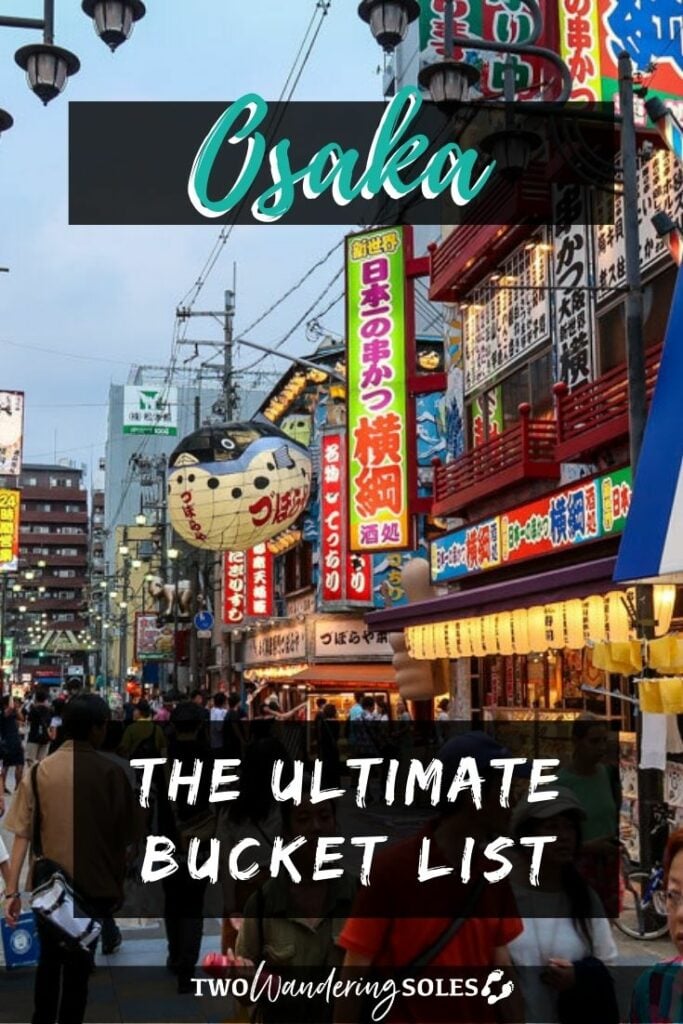
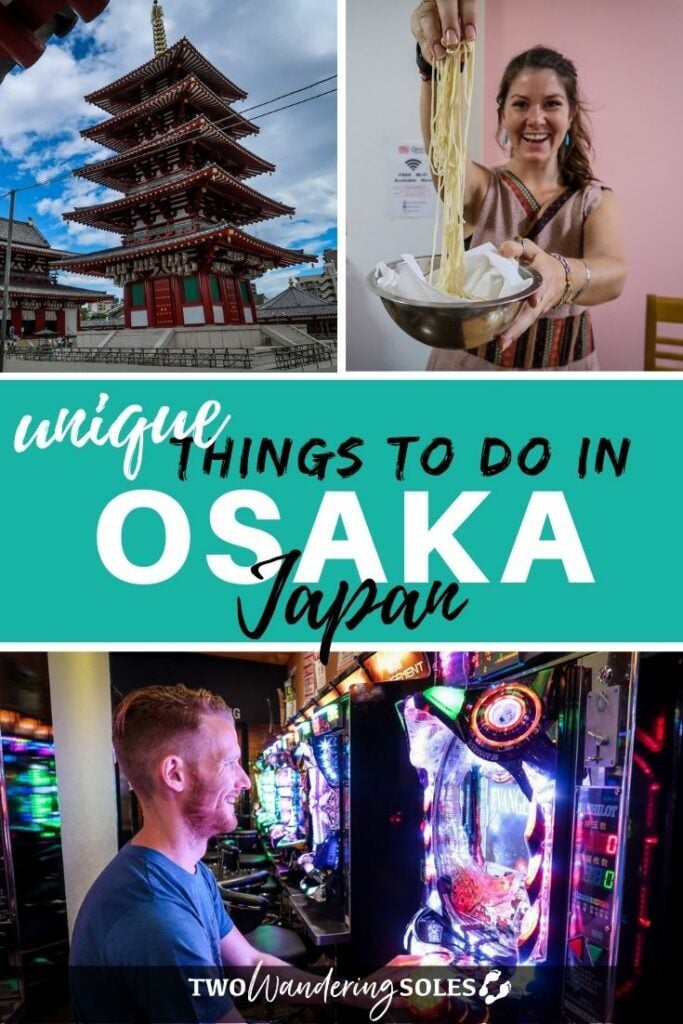
We want to hear from you!
What do you think about this list of things to do in Osaka, Japan? What would you add to the list? Do you know of any other hidden gems? Do you have any questions about traveling in Osaka? Let us know in the comments below!

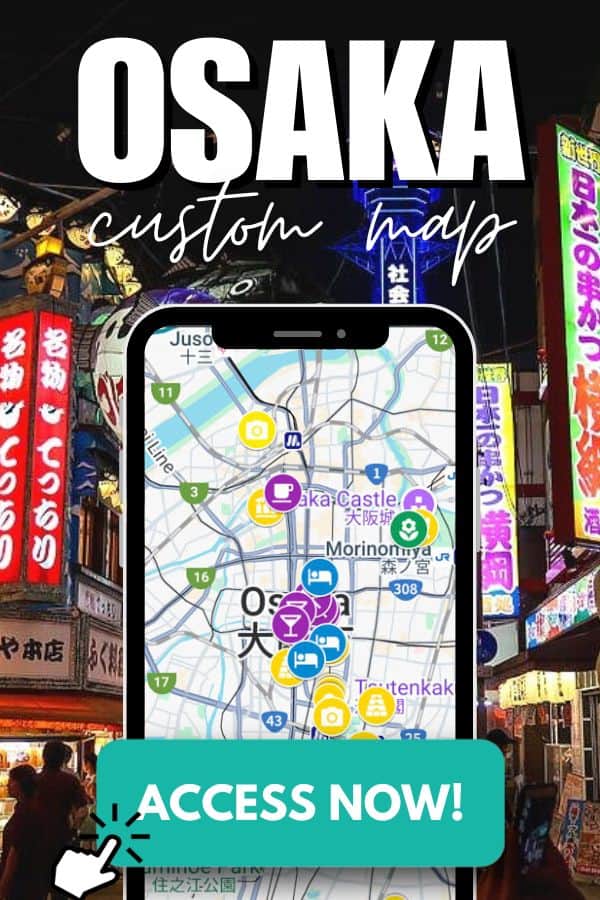
My husband, adult son, and myself will be in Japan mid June. We only have 8 days. We were thinking of staying in Nara for 3 nights and seeing Kyoto and Osaka during those days. After reading your website, maybe it would be better to stay in Kyoto for 3 nights and do day trips to Nara and Osaka. Thoughts?
I’m so excited to visit Osaka! I’ve heard so many great things about it. I can’t wait to check out all the exciting things to do!
I’m so excited to visit Osaka! I’ve heard so many great things about it. I can’t wait to check out all the exciting things to do!
Hope you have a great time in Osaka!
Fantastic resource, I’ll now plan to spend longer in Osaka after reading this.
Definitely! Osaka is worth the extra time, there is so much to do and see there!
I’m so excited to visit Osaka! I’ve heard so many great things about it. I can’t wait to check out all the exciting things to do!
Great job Katie – that’s an epic post and goes well beyond Osaka too. And I think you’re bang on about its ‘character’ is what sets it apart and makes it worth revisiting time after time.
I particularly like some of your ‘off-the-beaten-path’ suggestions. That ‘speakeasy’ looks like a rare find and nice to see Sinsekai getting a shout out too. (I always recommend it to new timers to Osaka, give them a feel for the less polished side of the city.)
Another tip: for Shittenoji Temple, try to coincide your visit with the monthly flea market. The market takes place on the 21st and 22nd of every month. Arrive early to bag the best bargains.
Regarding your pictures inside a pachinko parlor which you didn’t mention: photography is banned in most pachinko parlors and permission should be gained before taking pics.